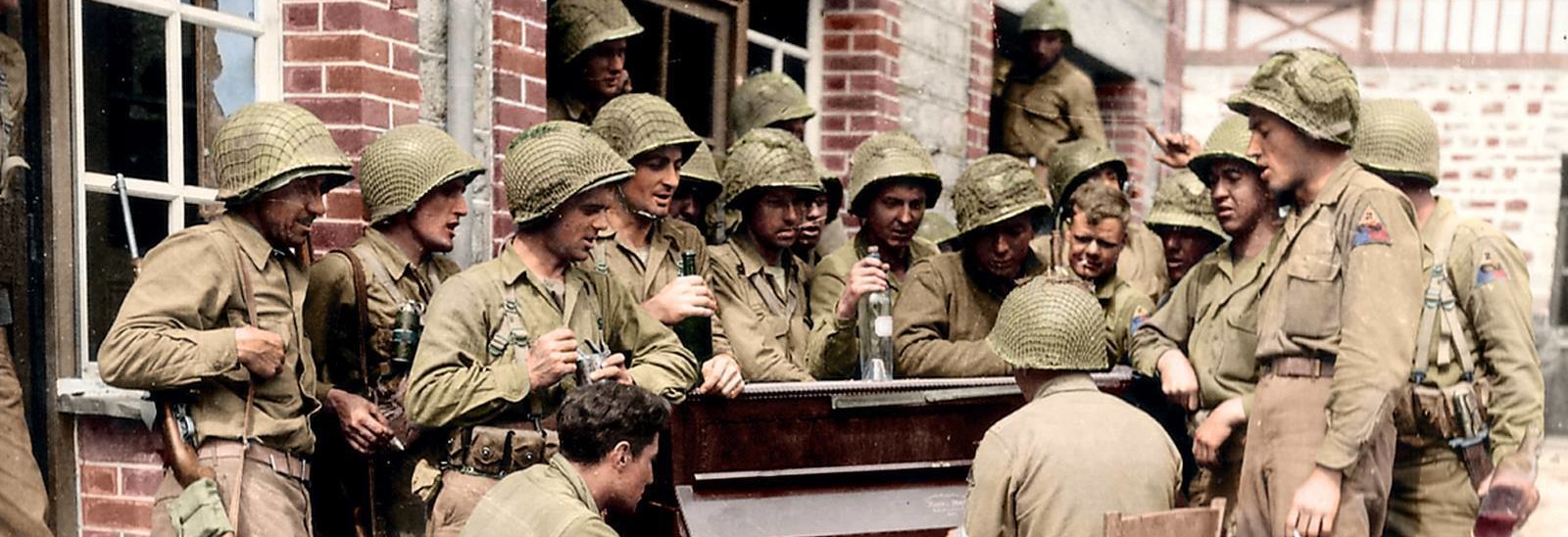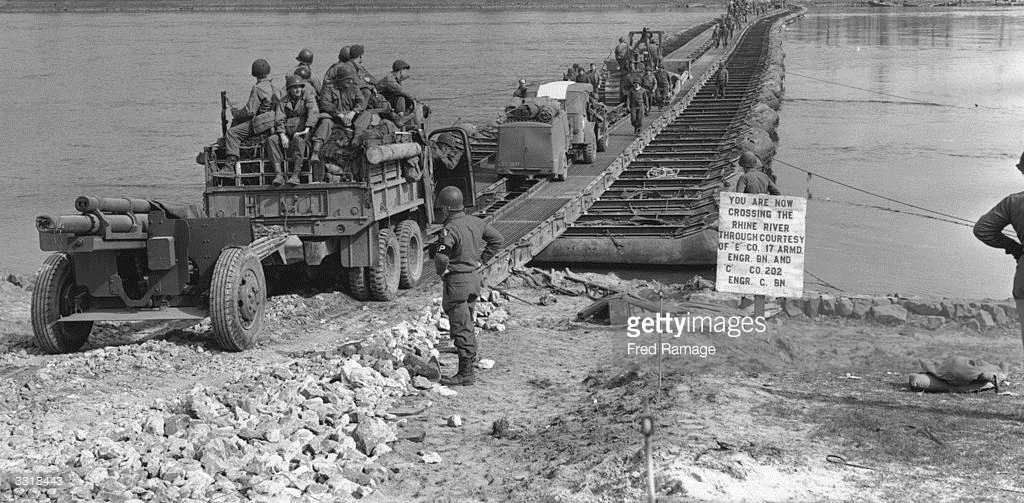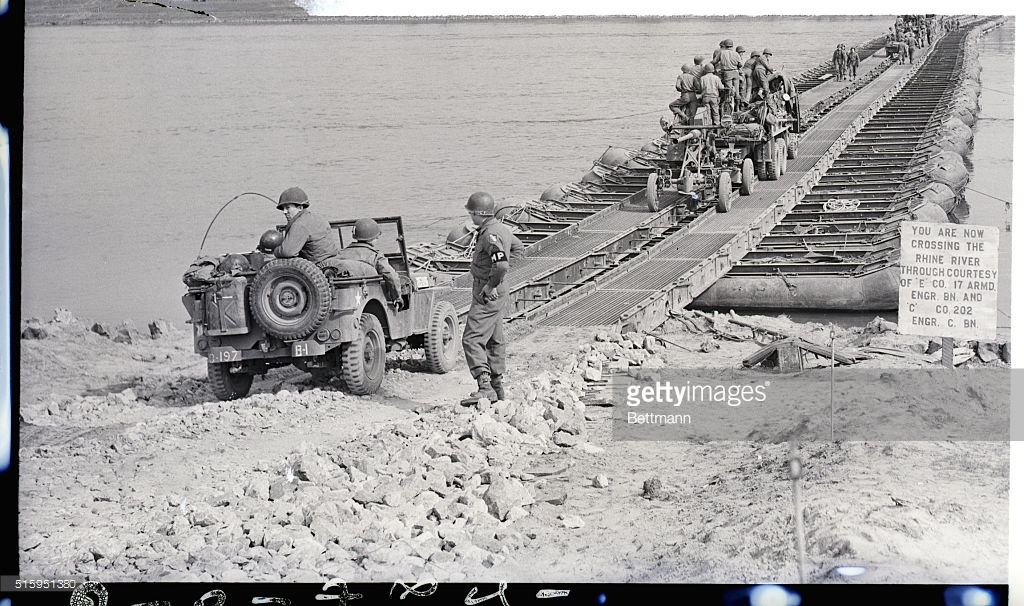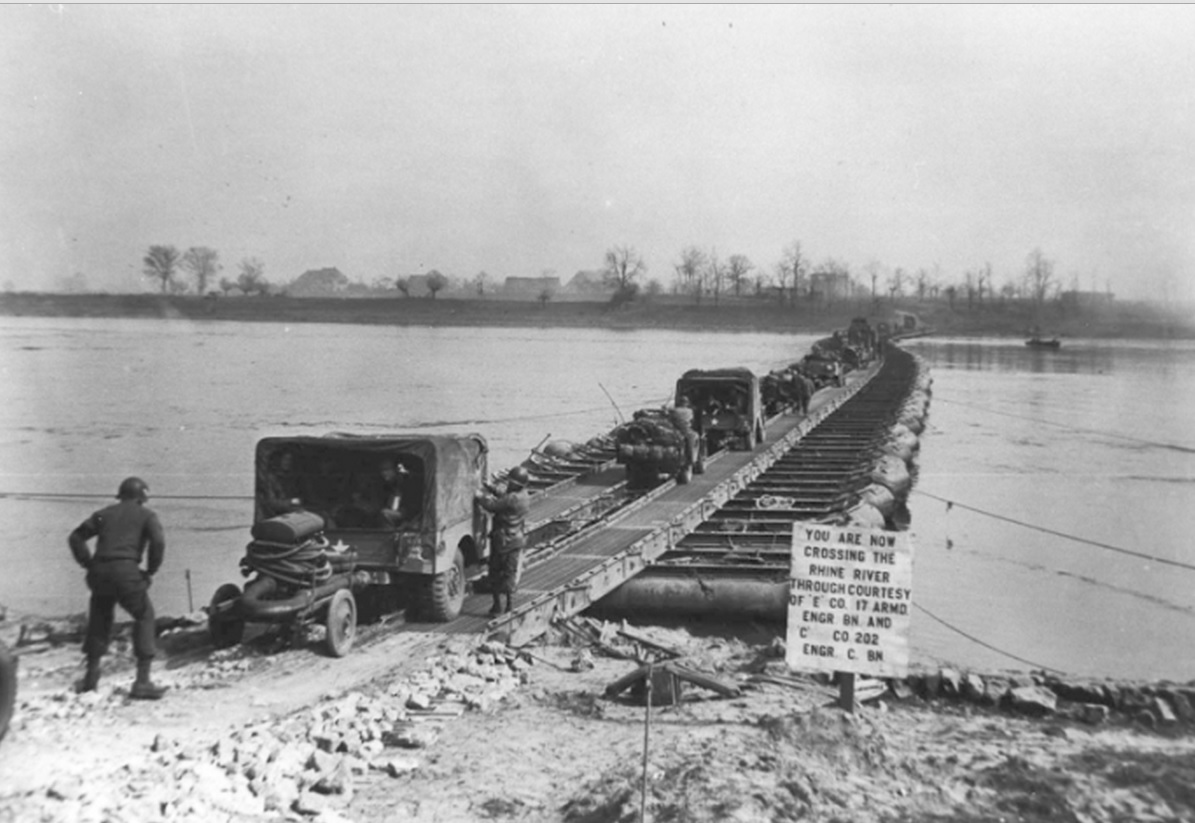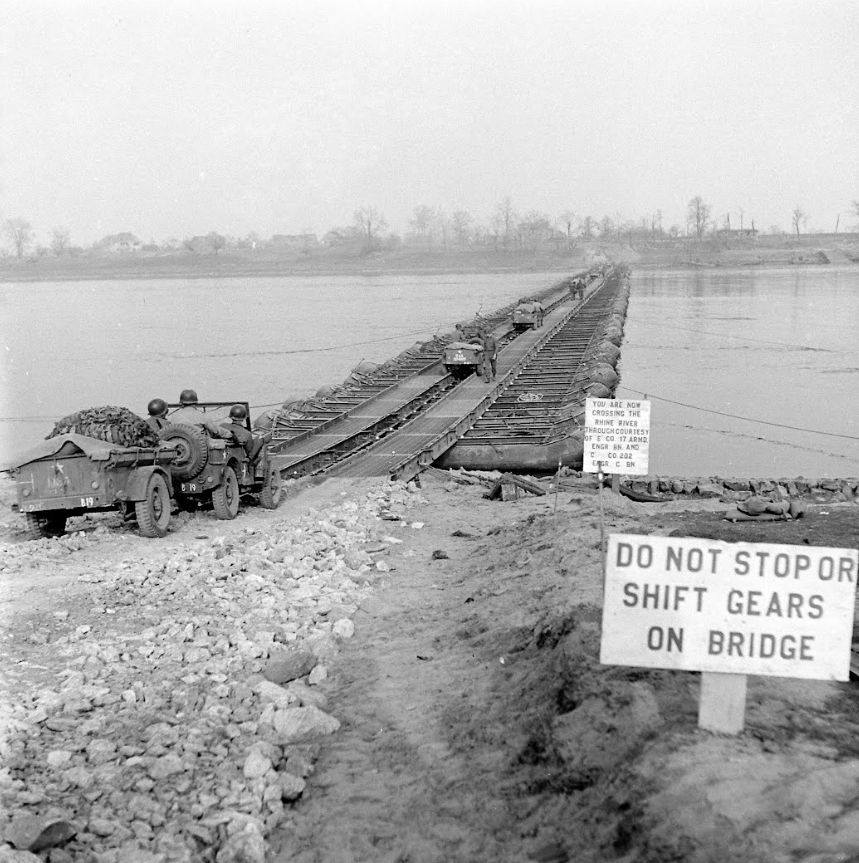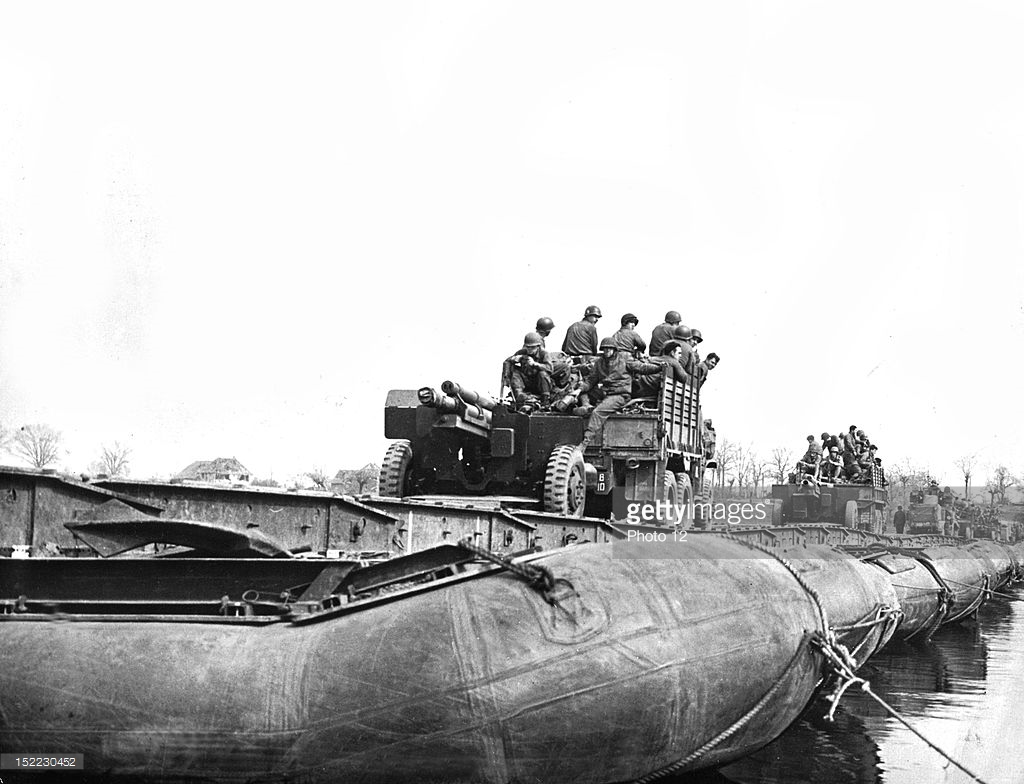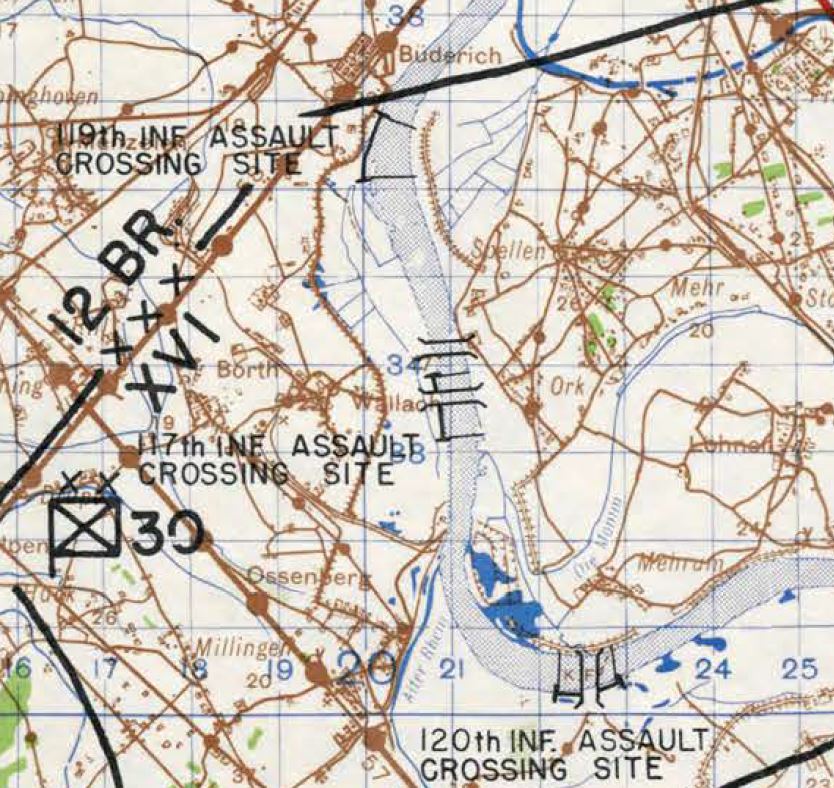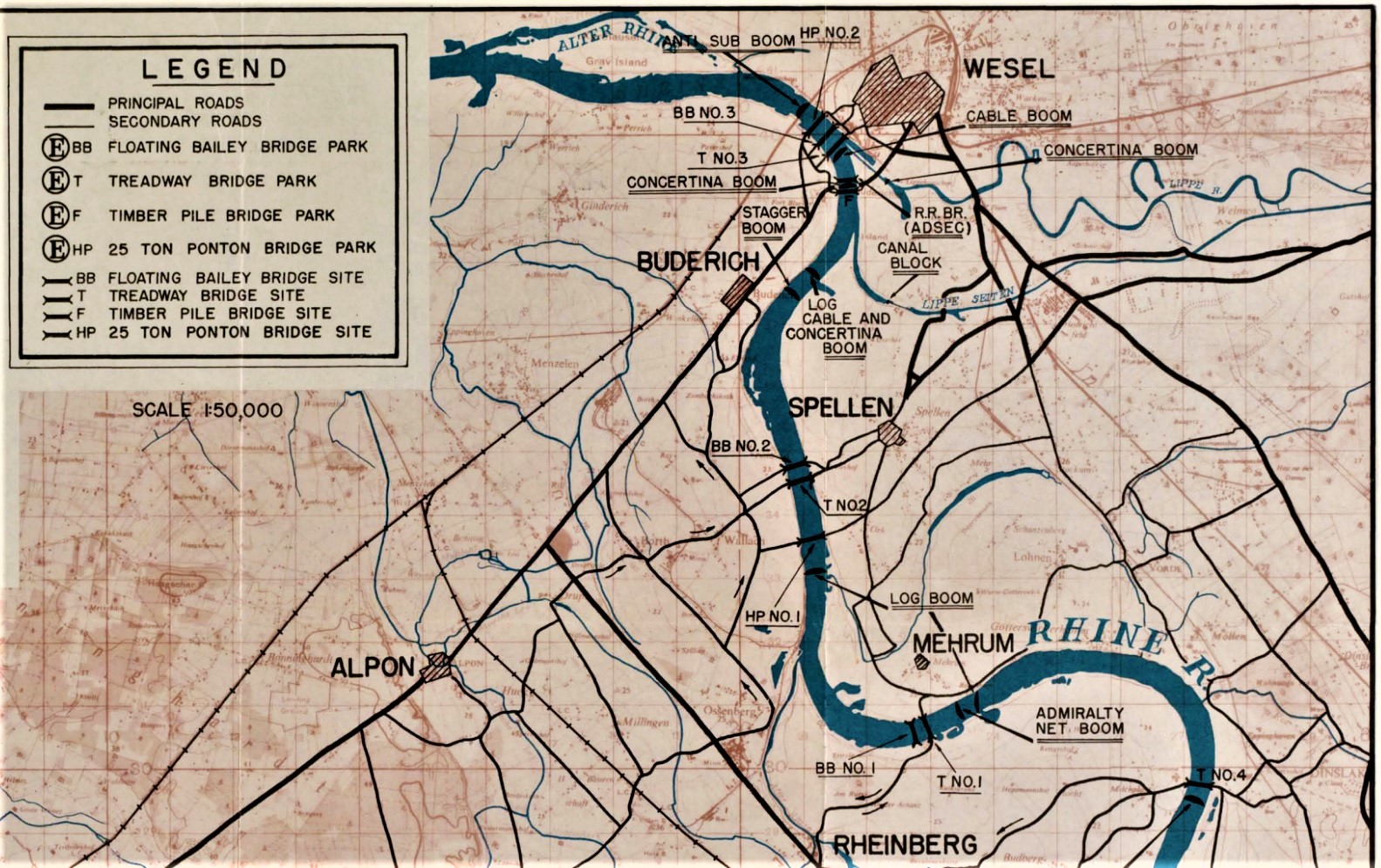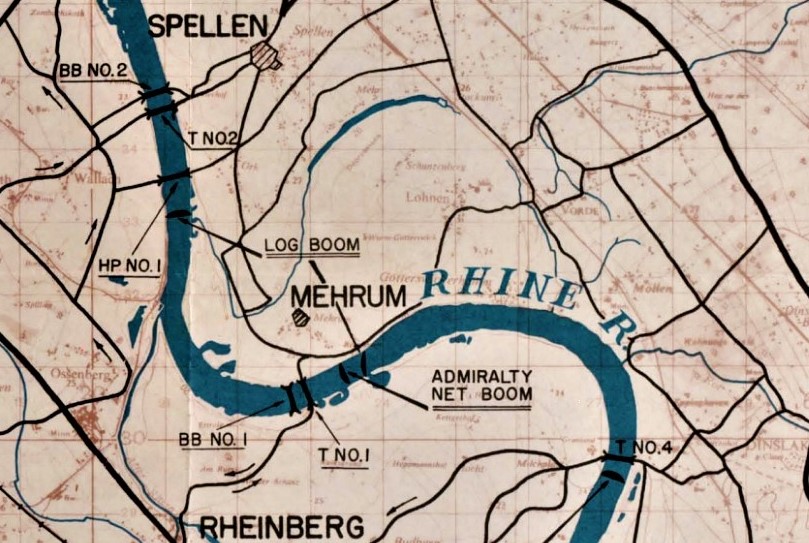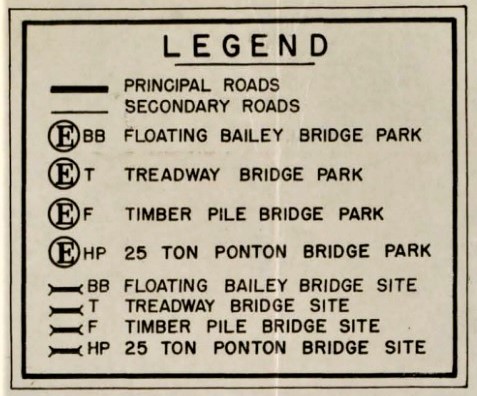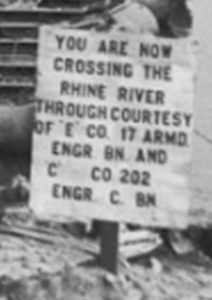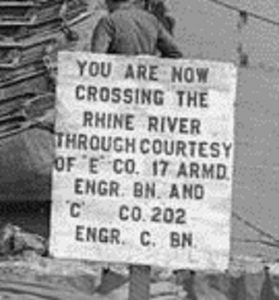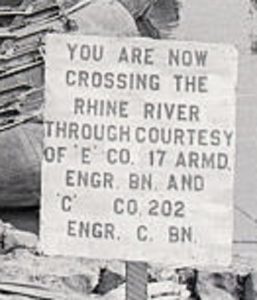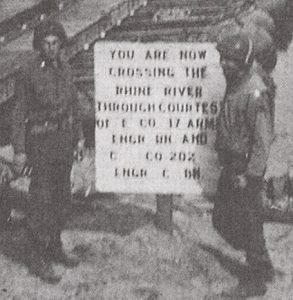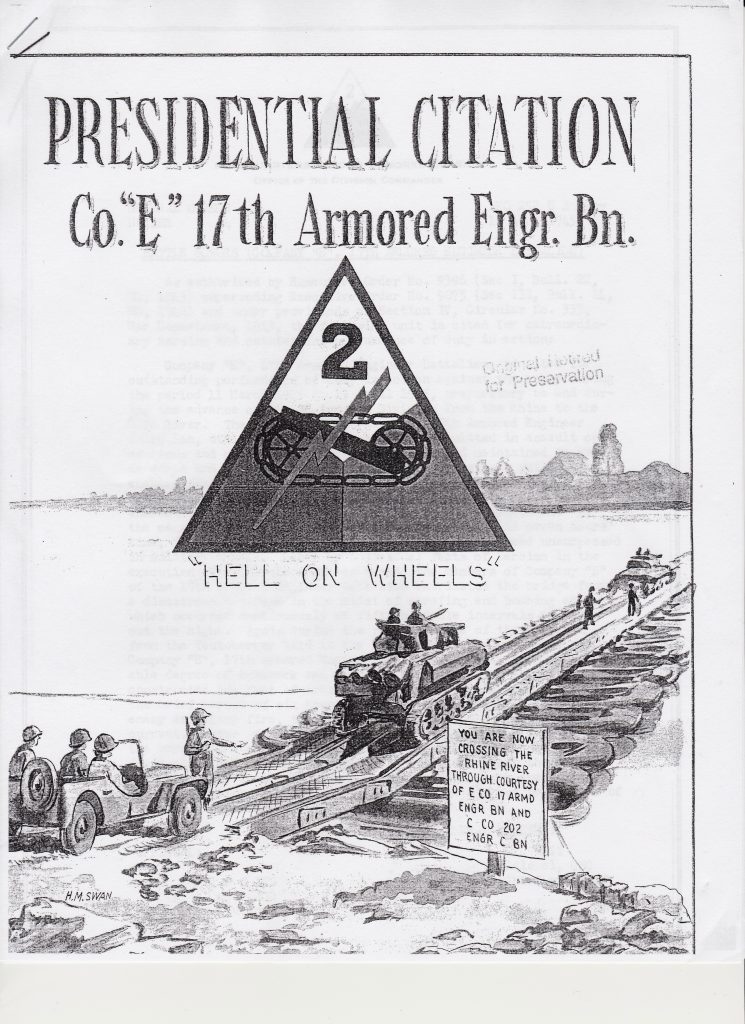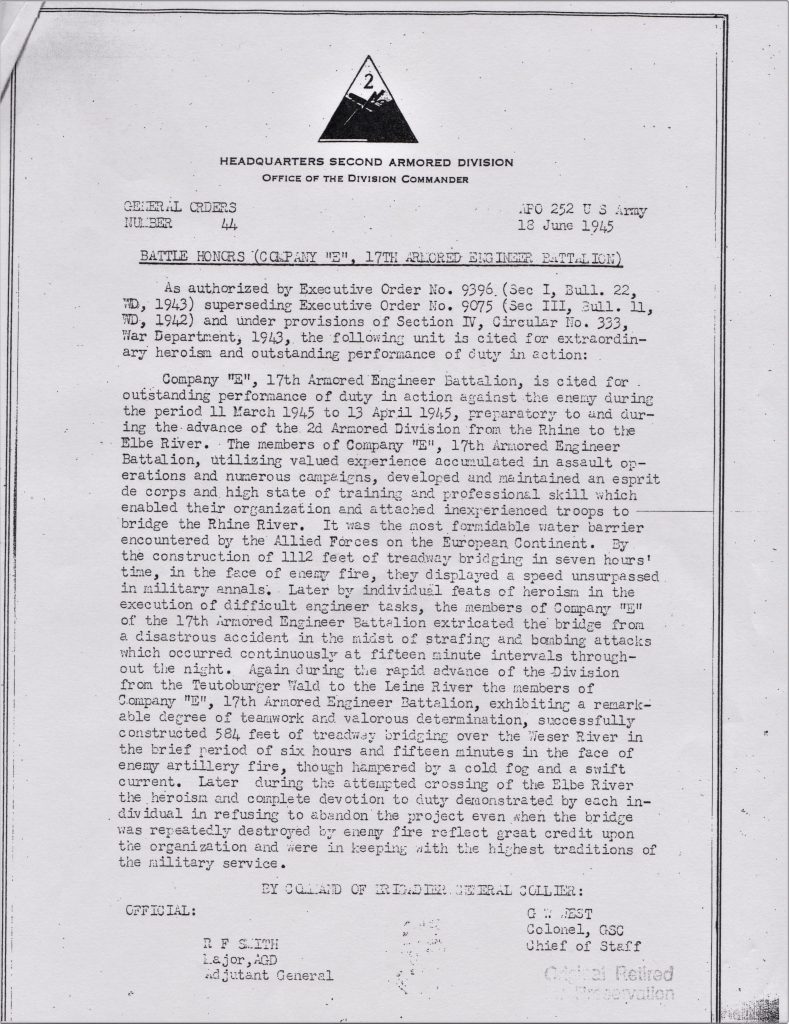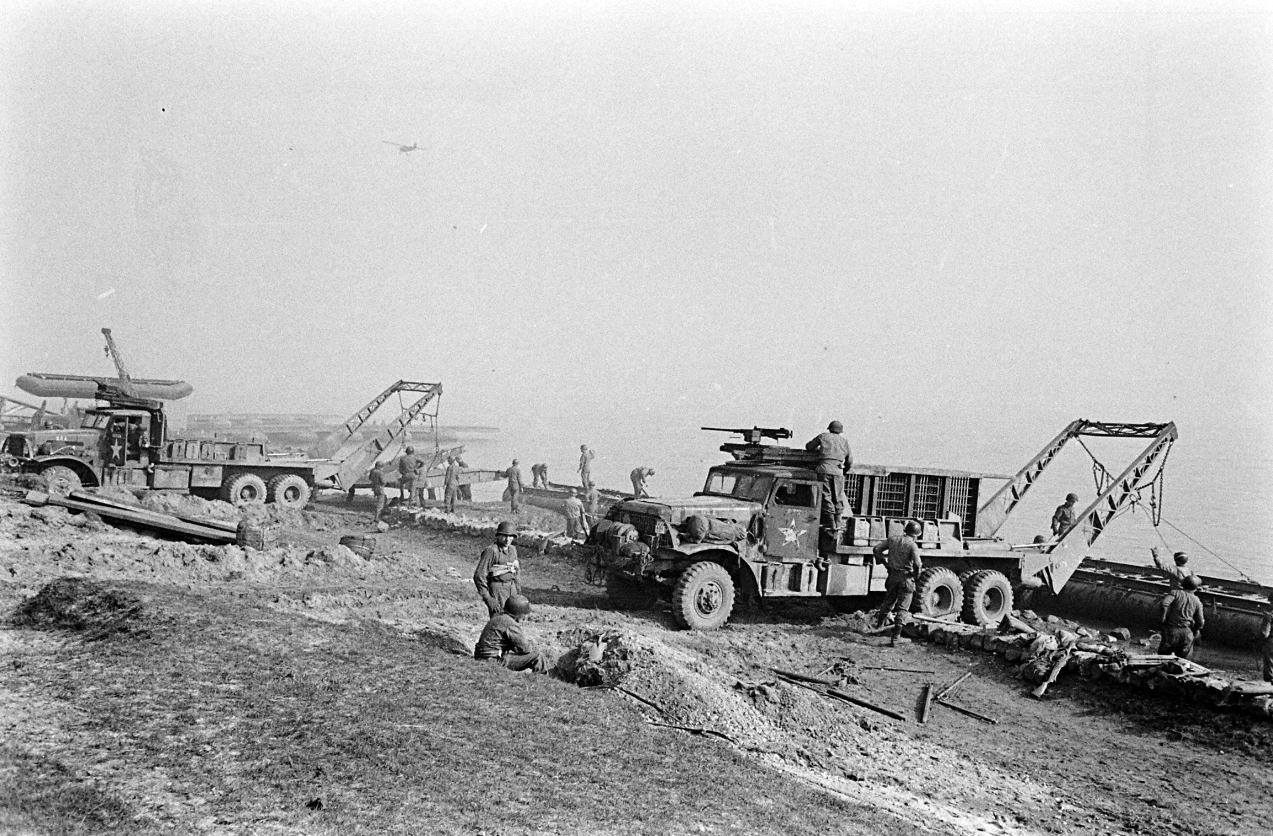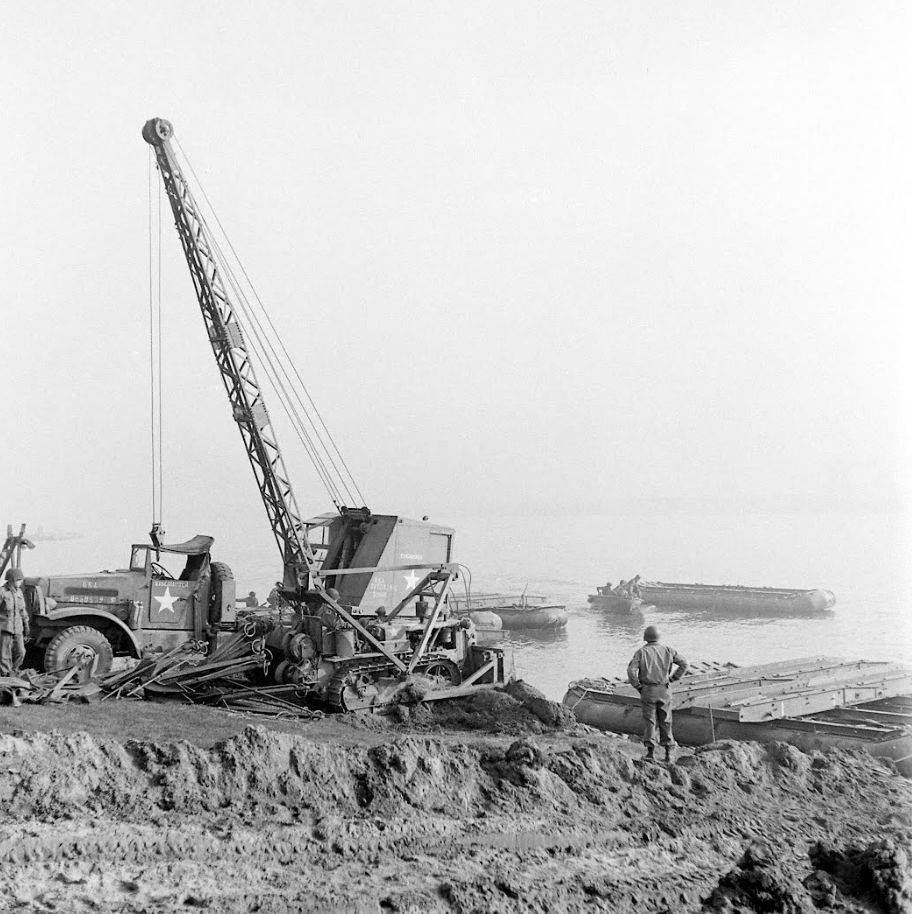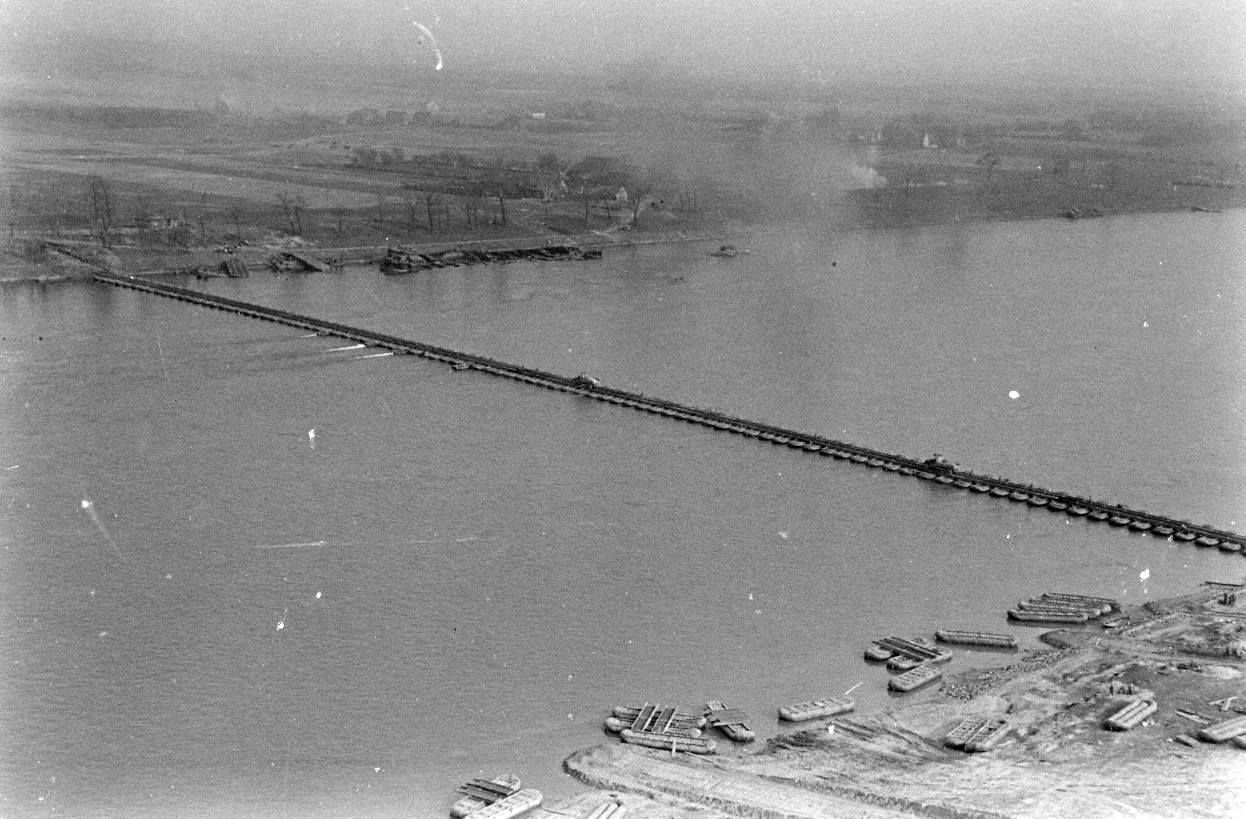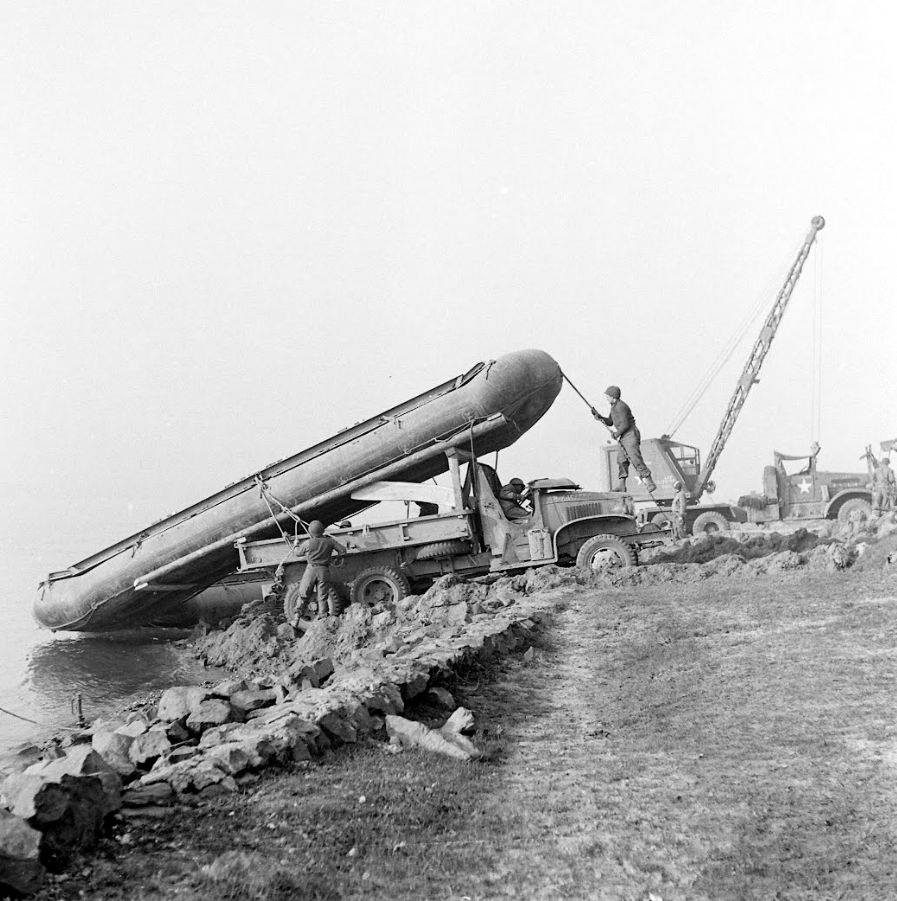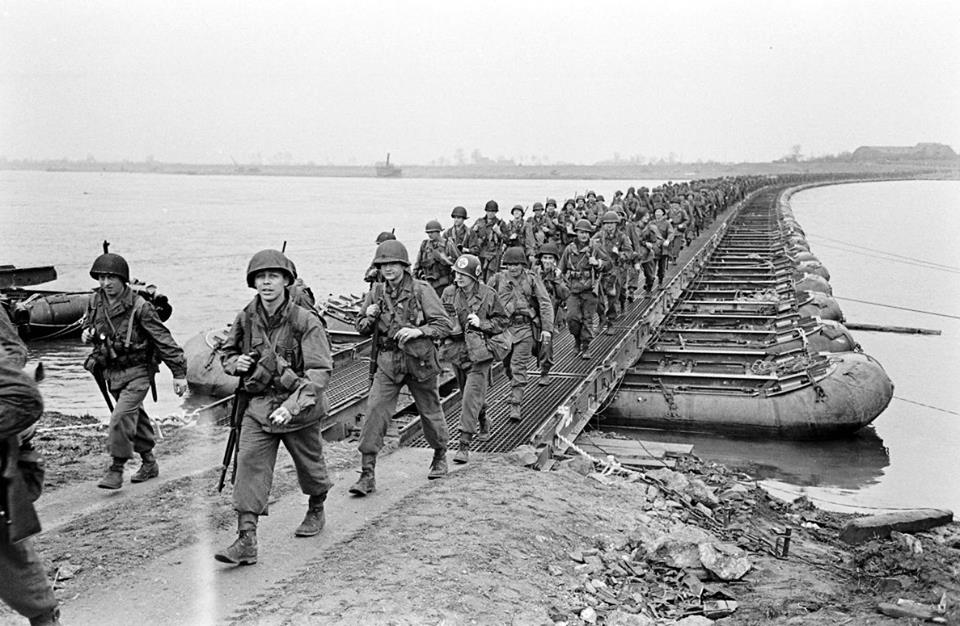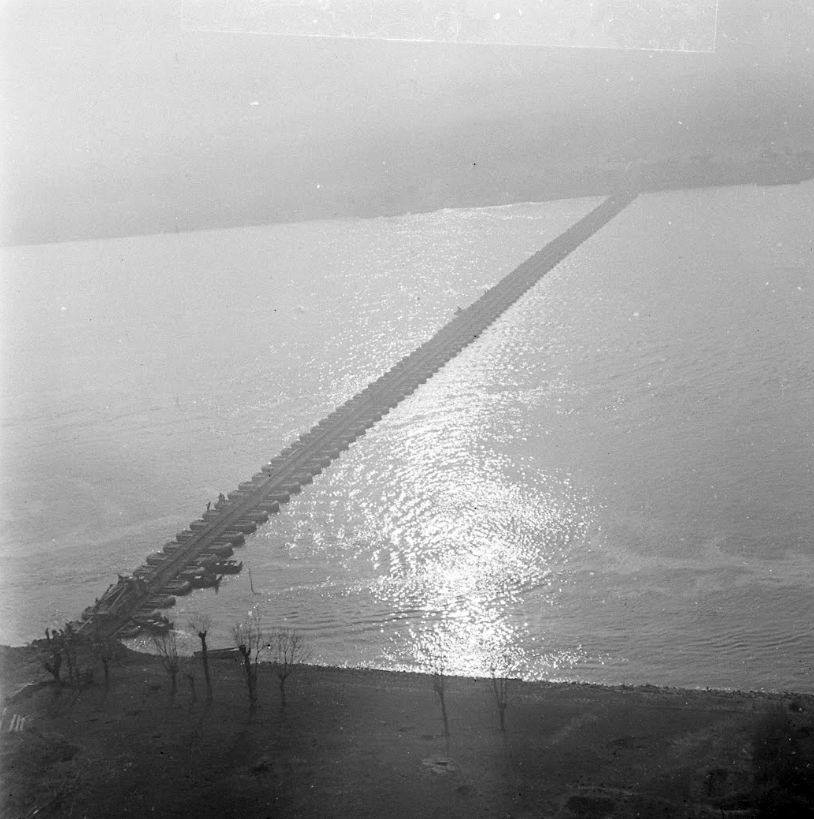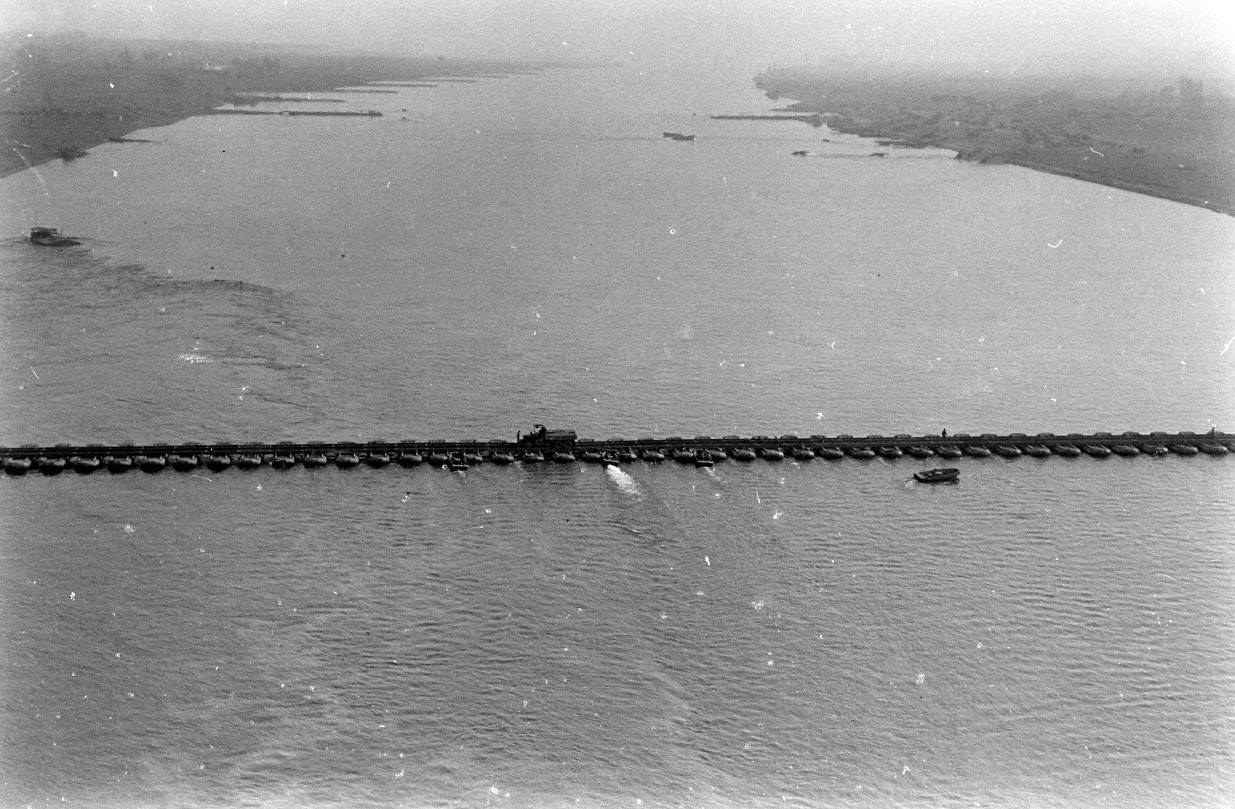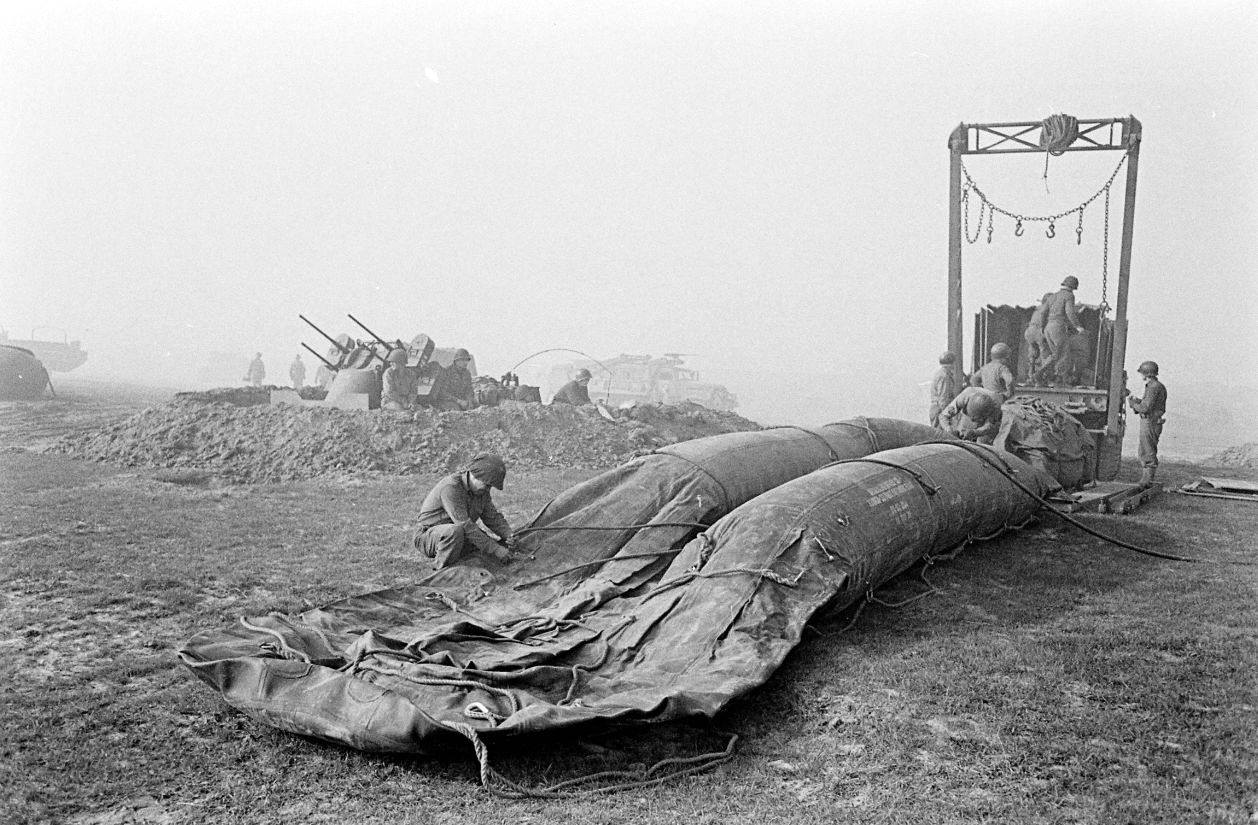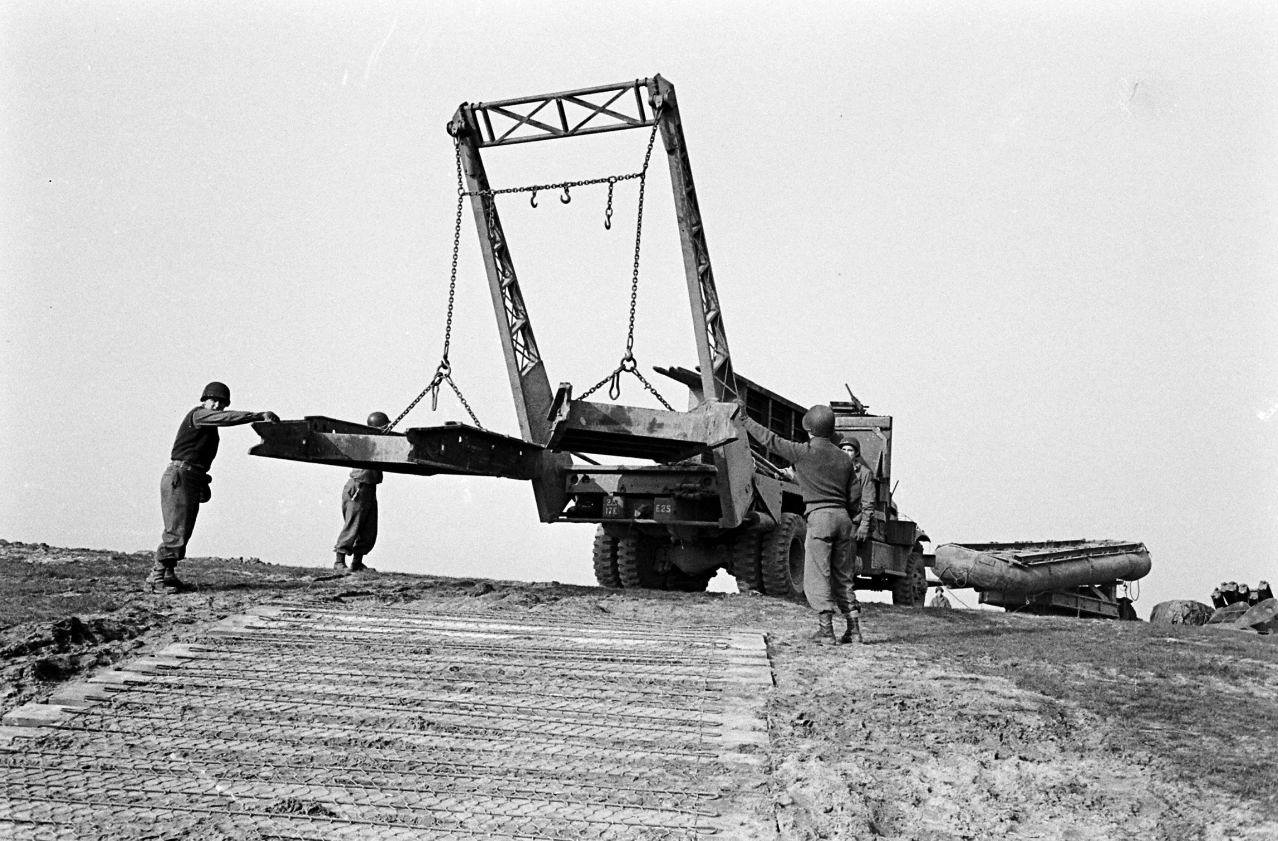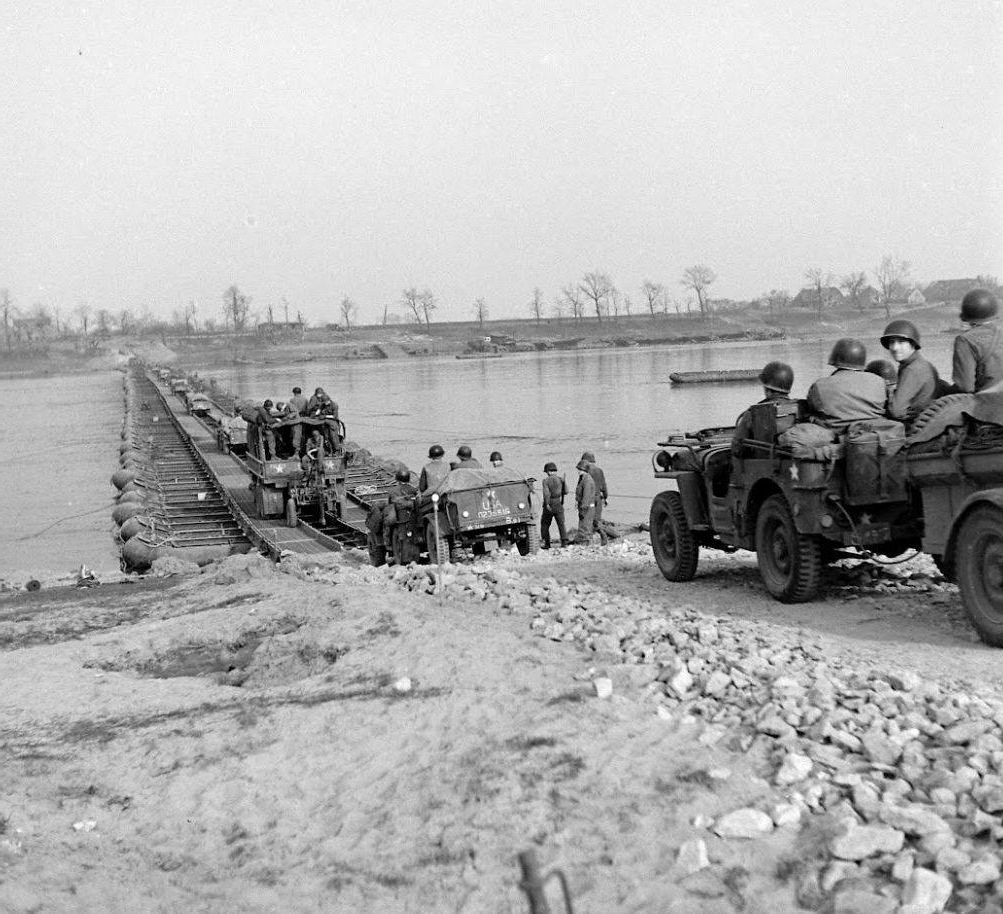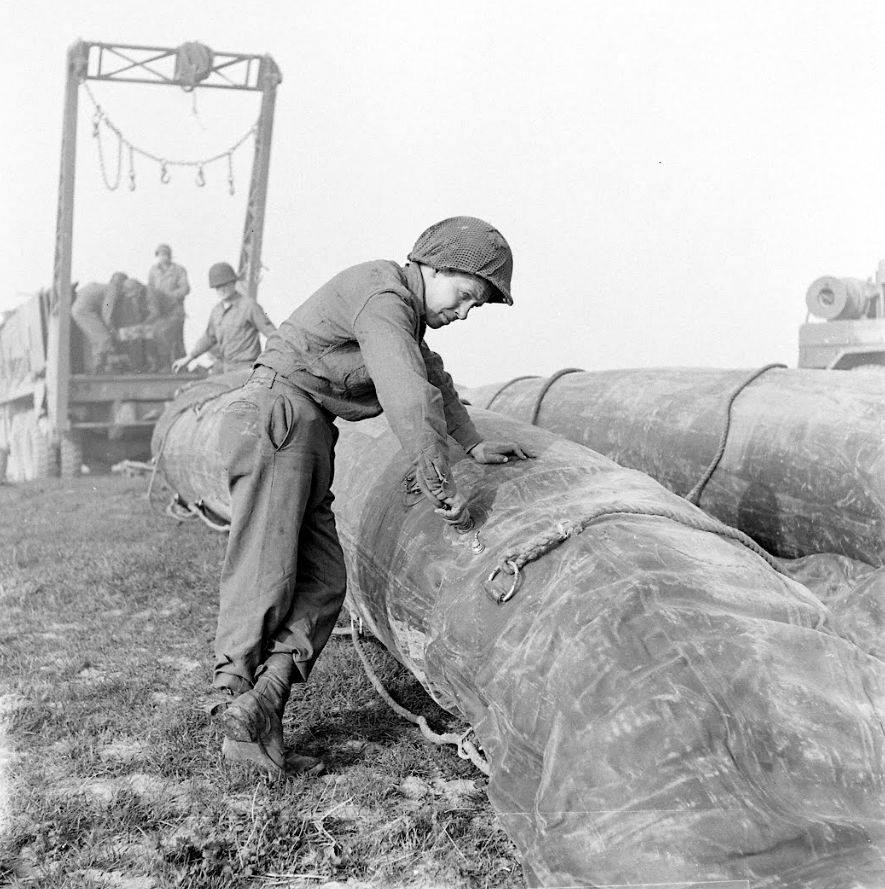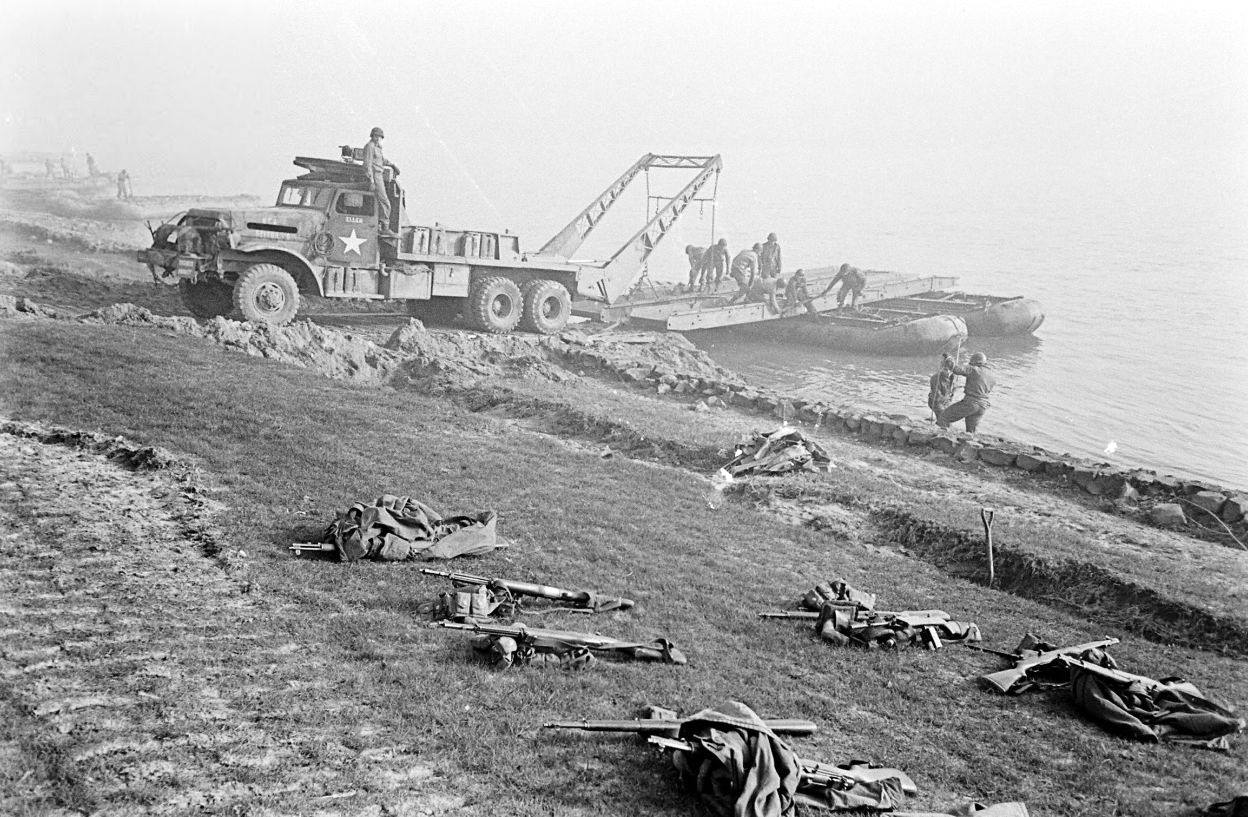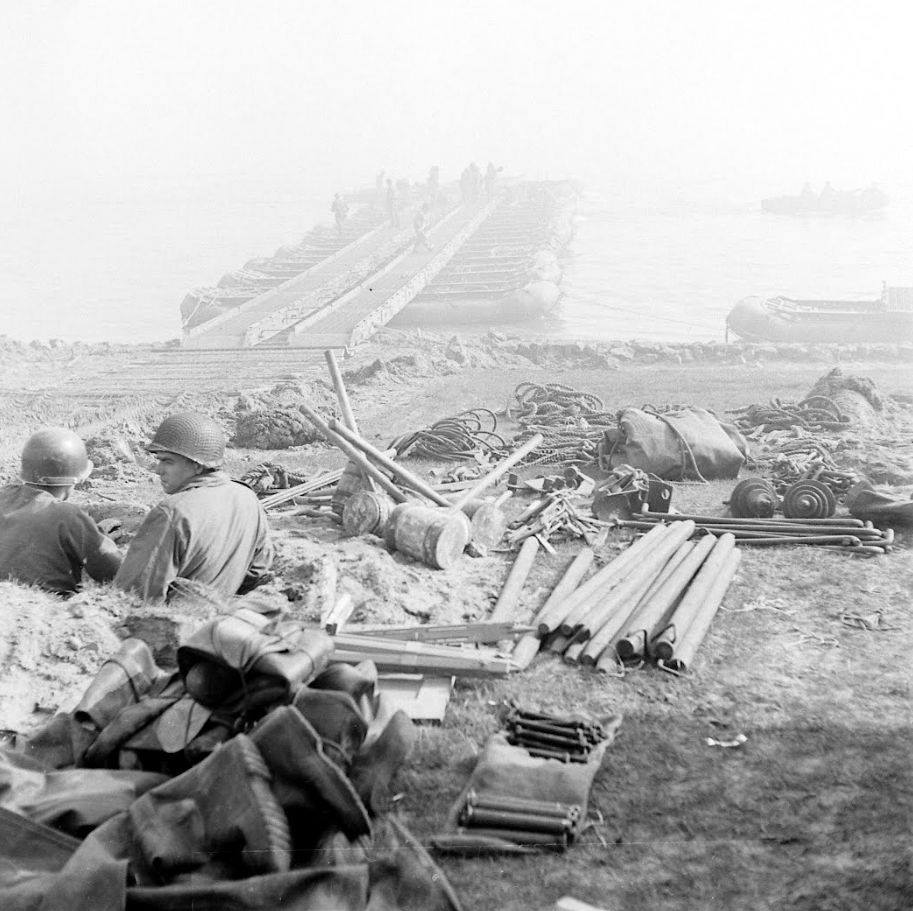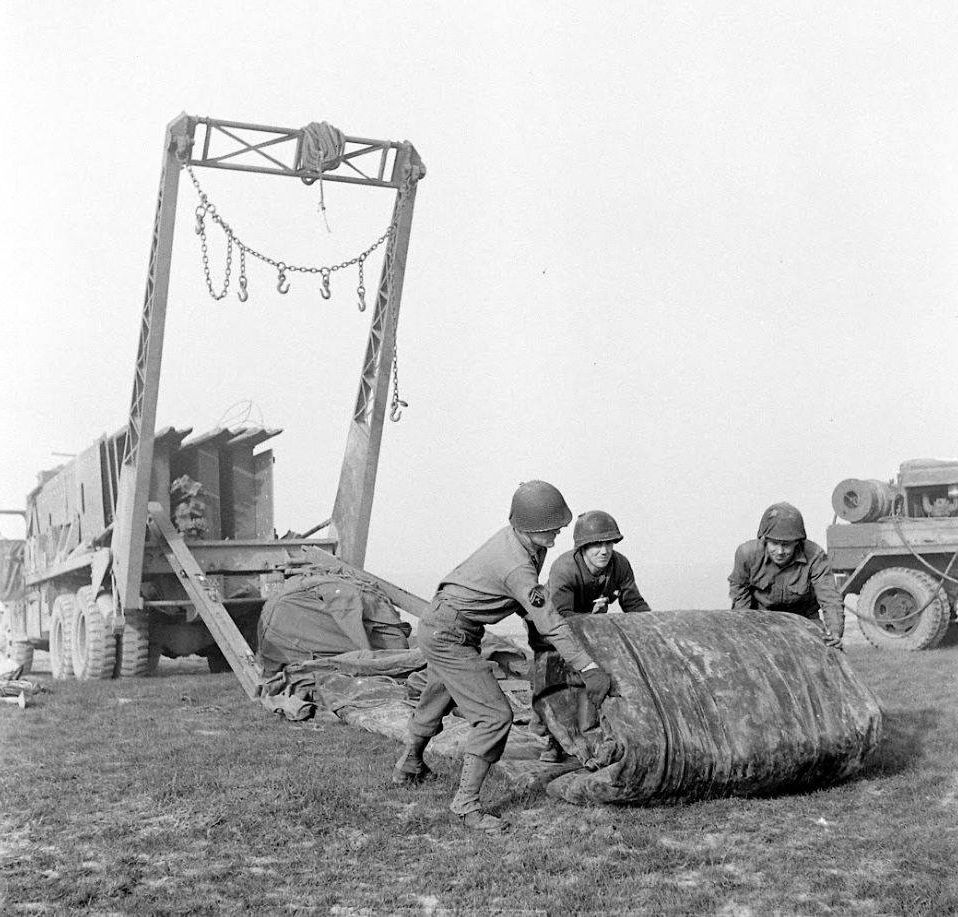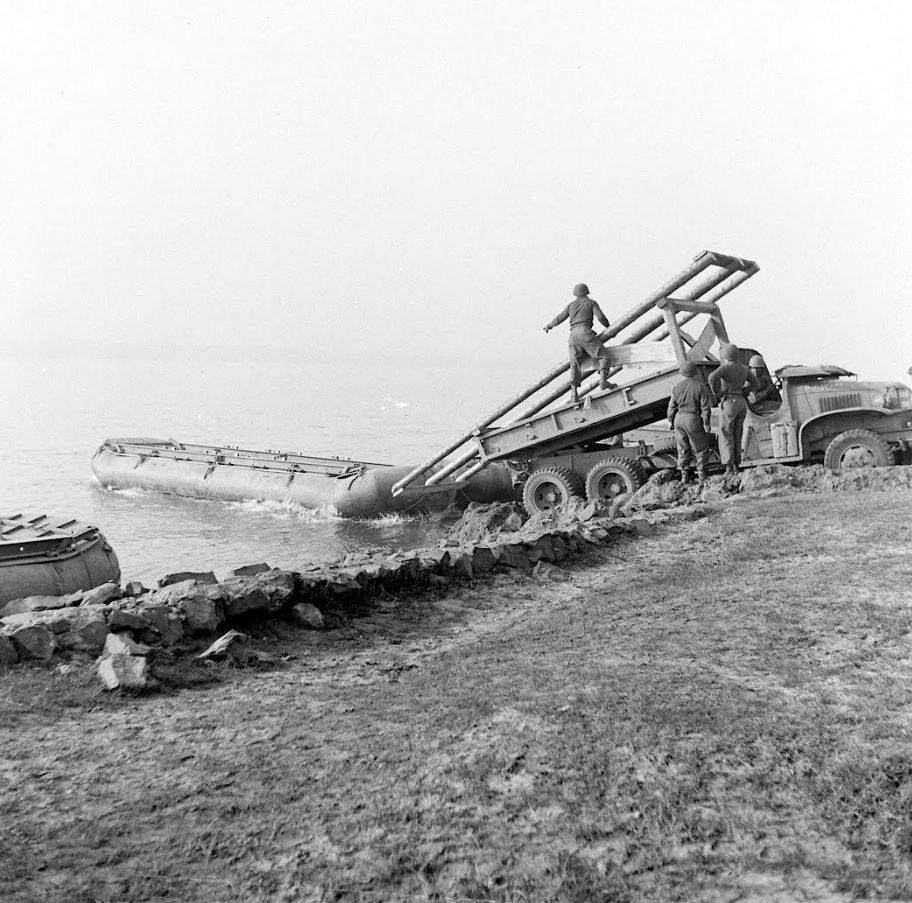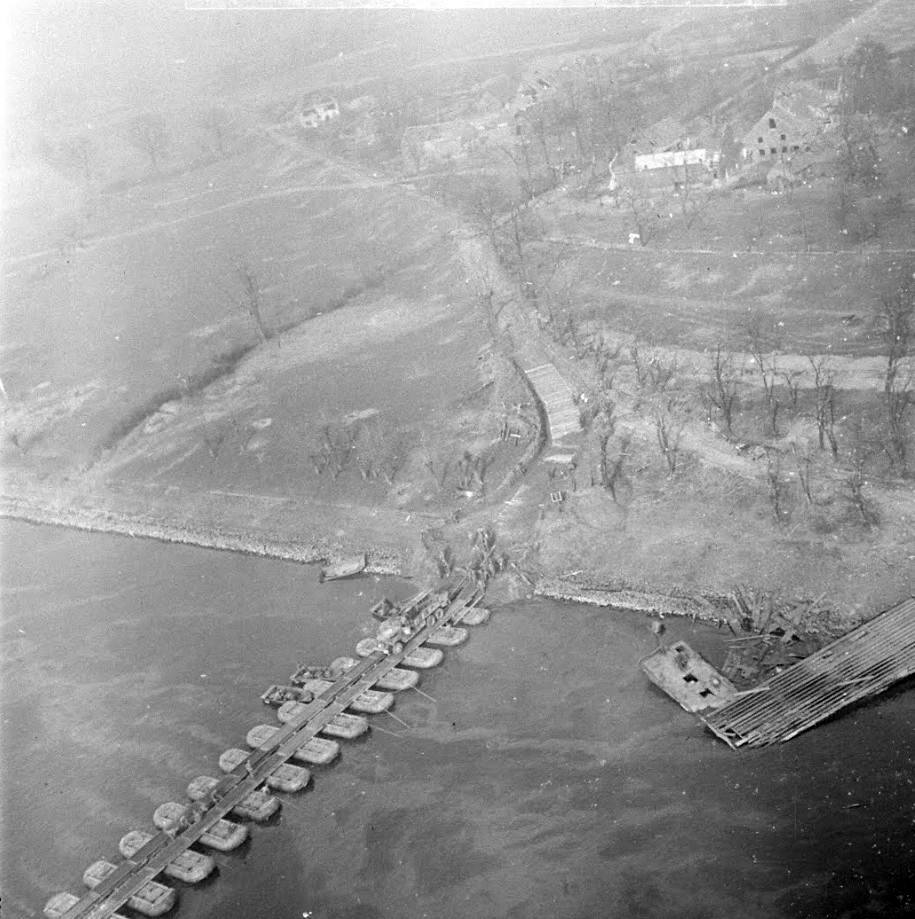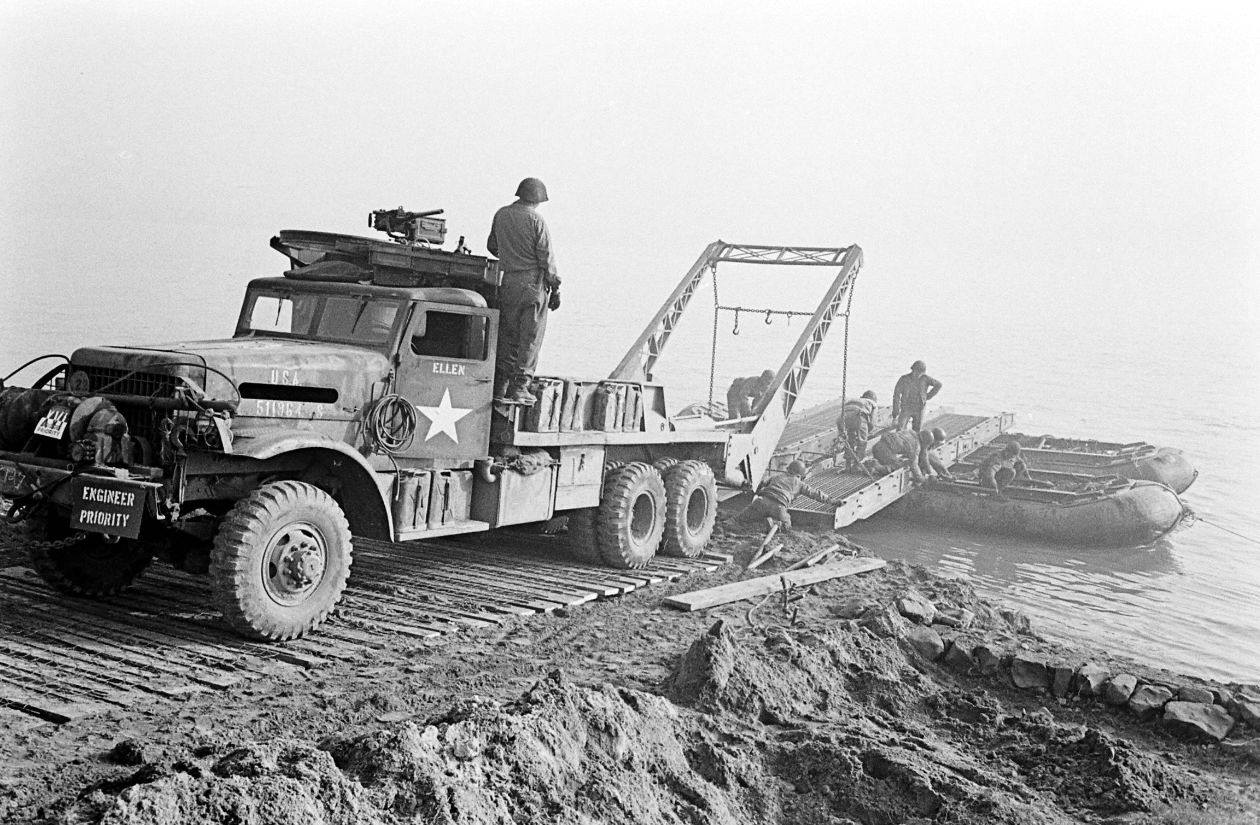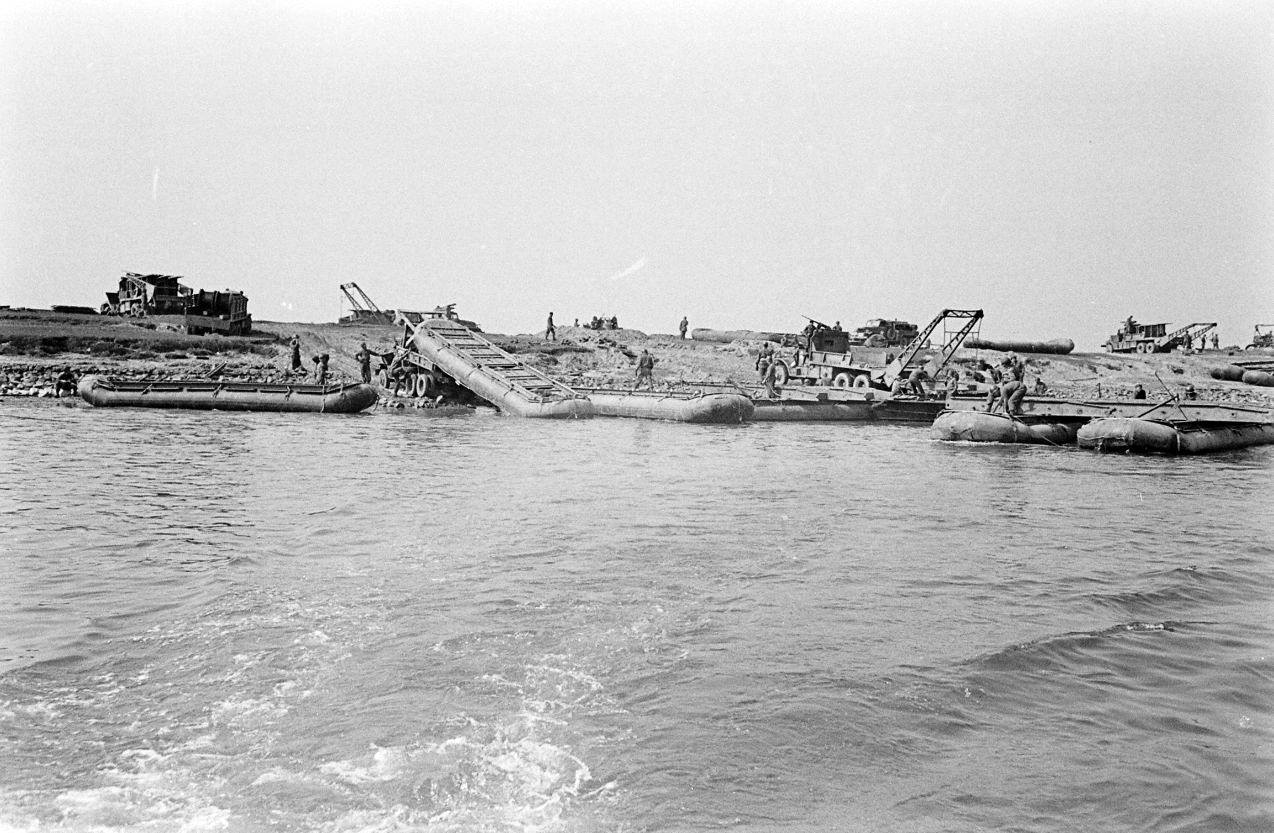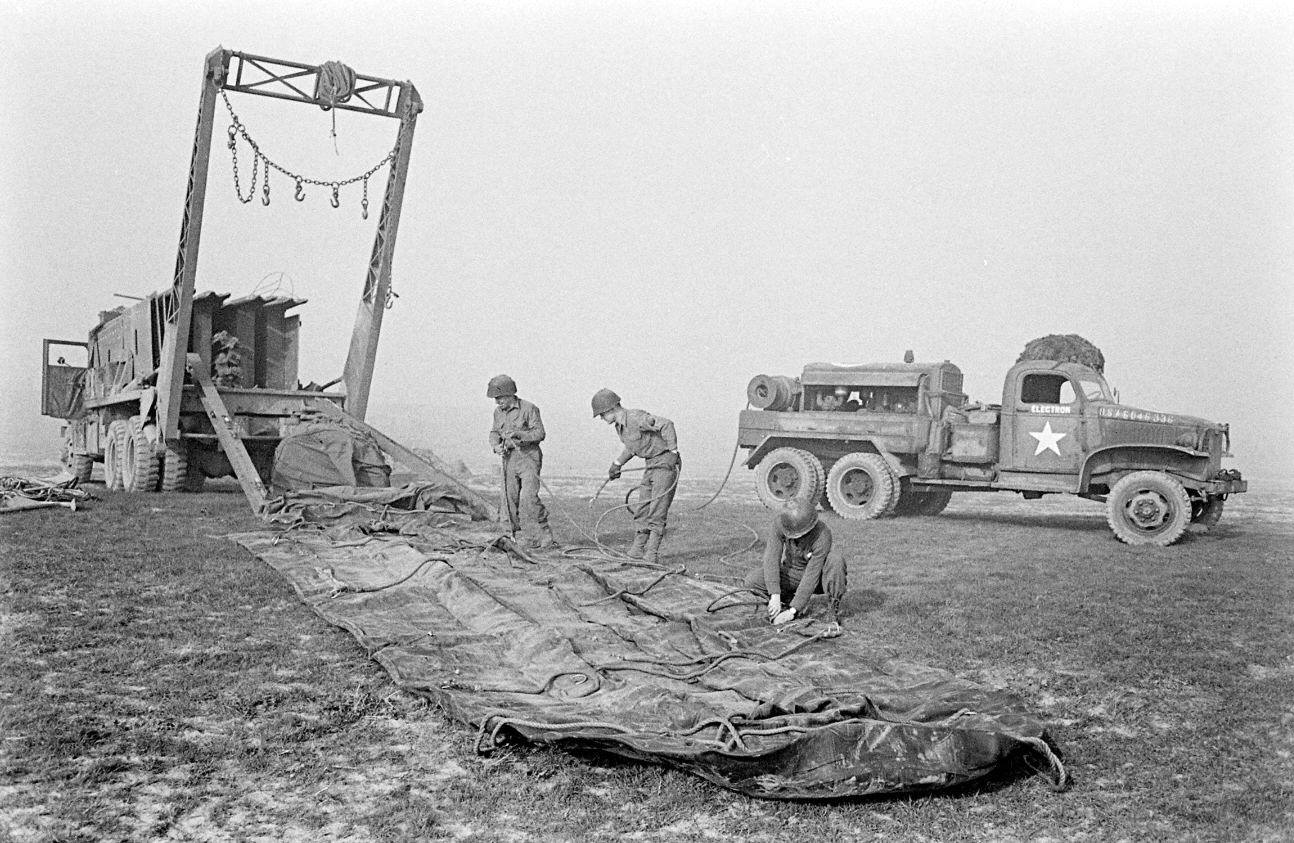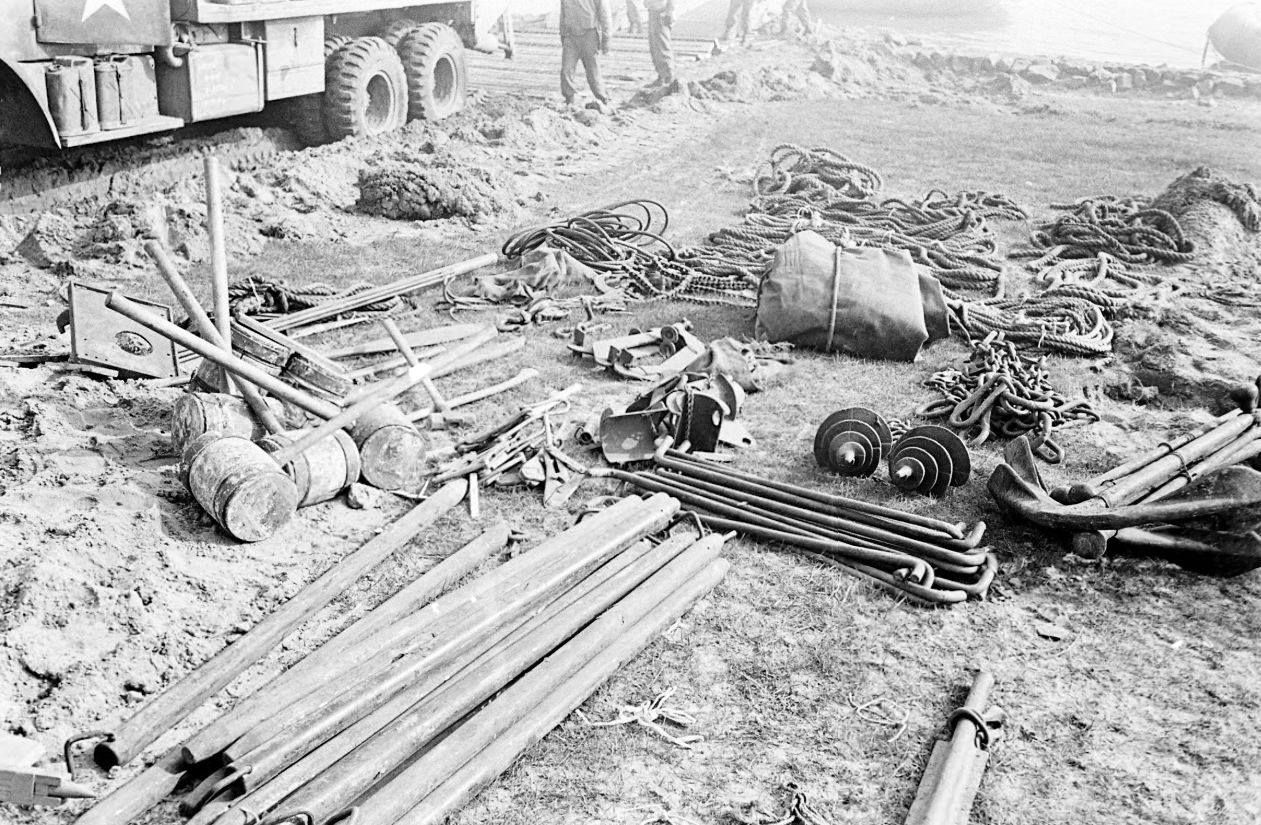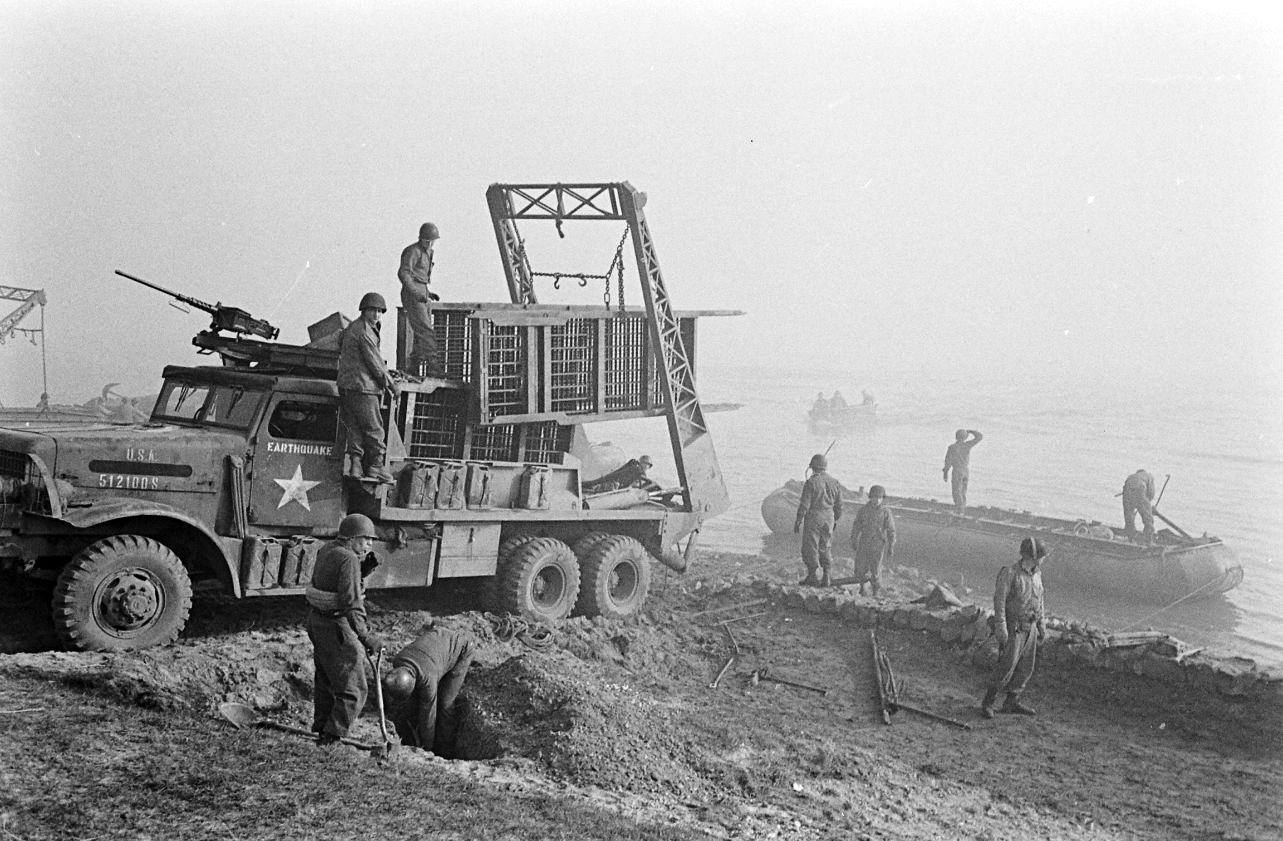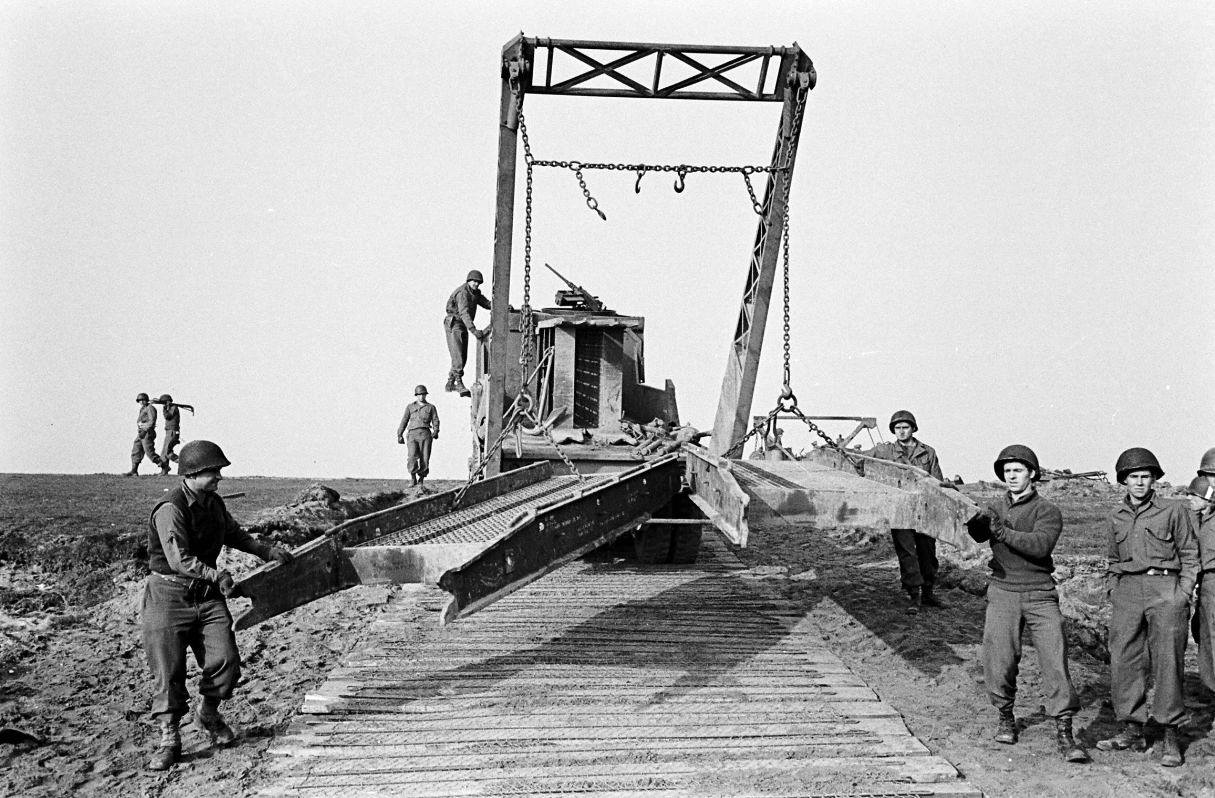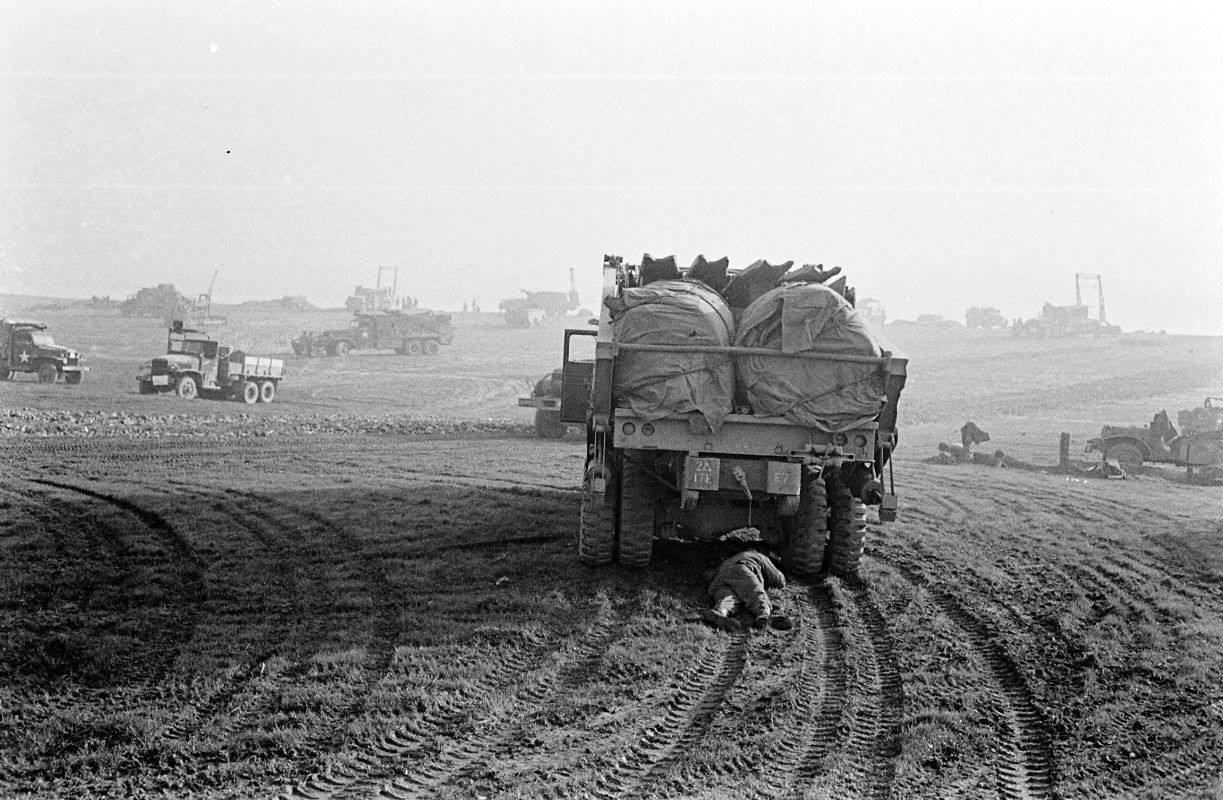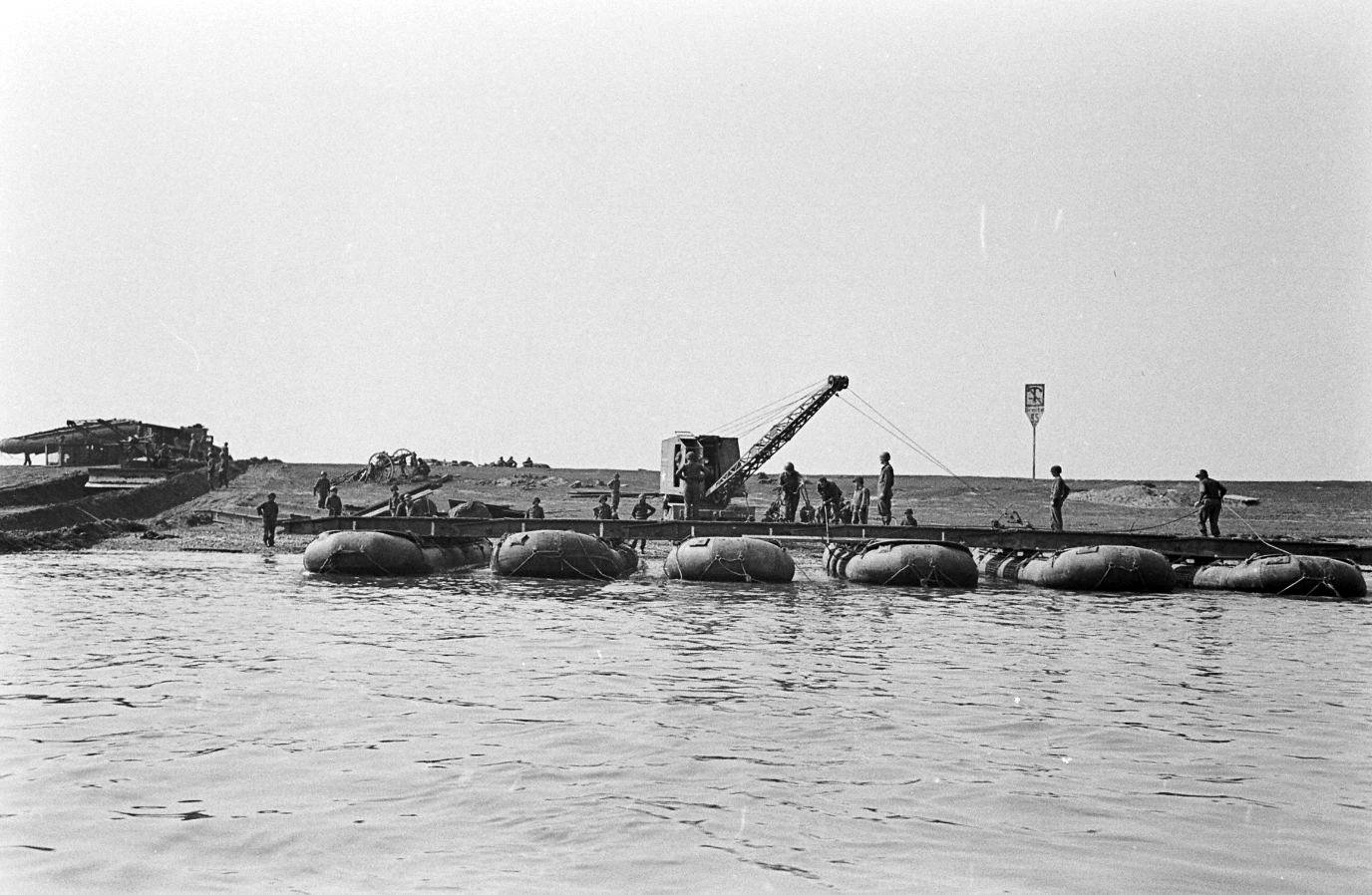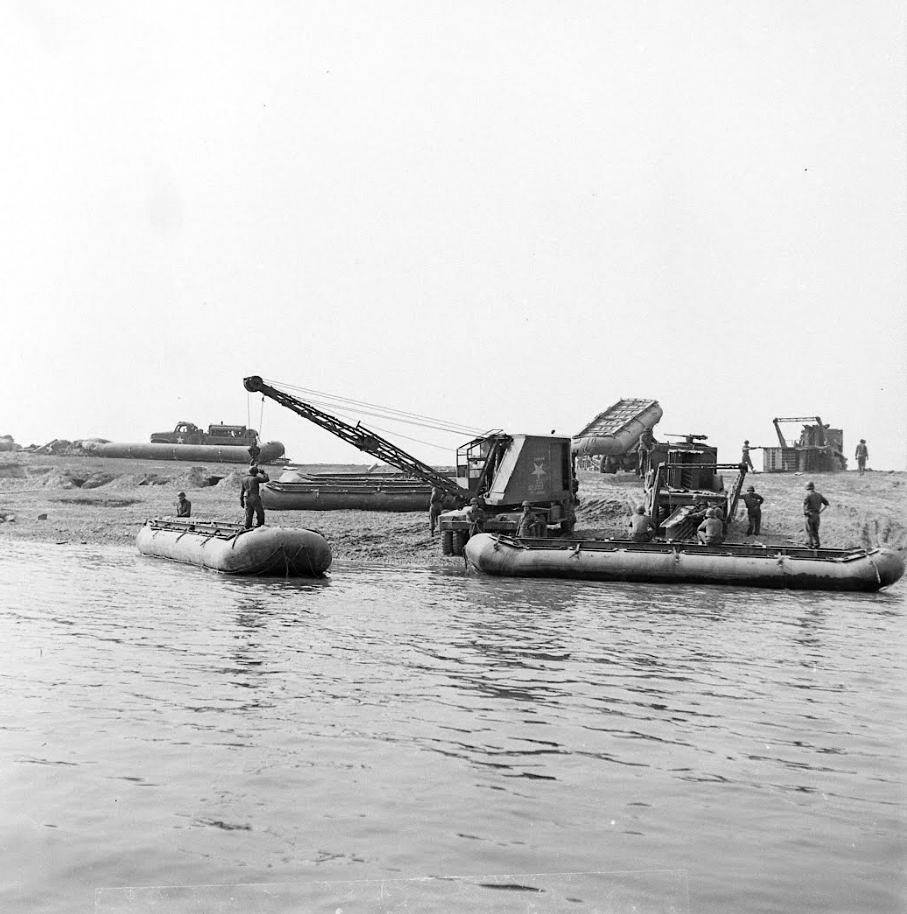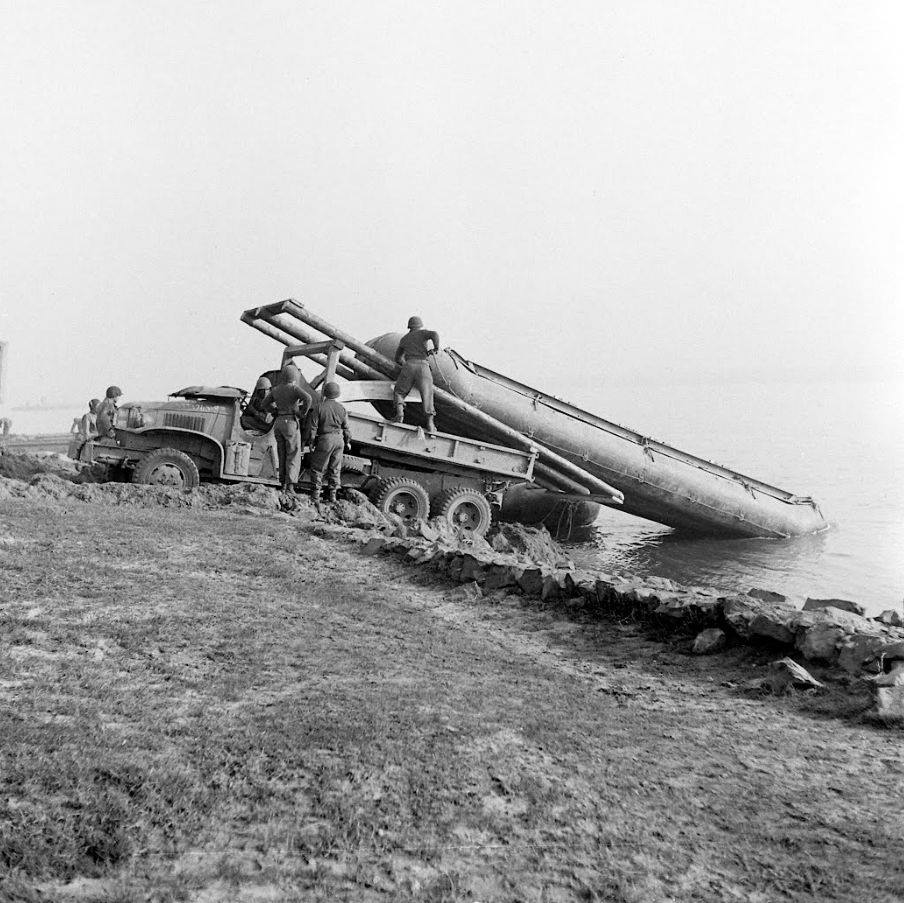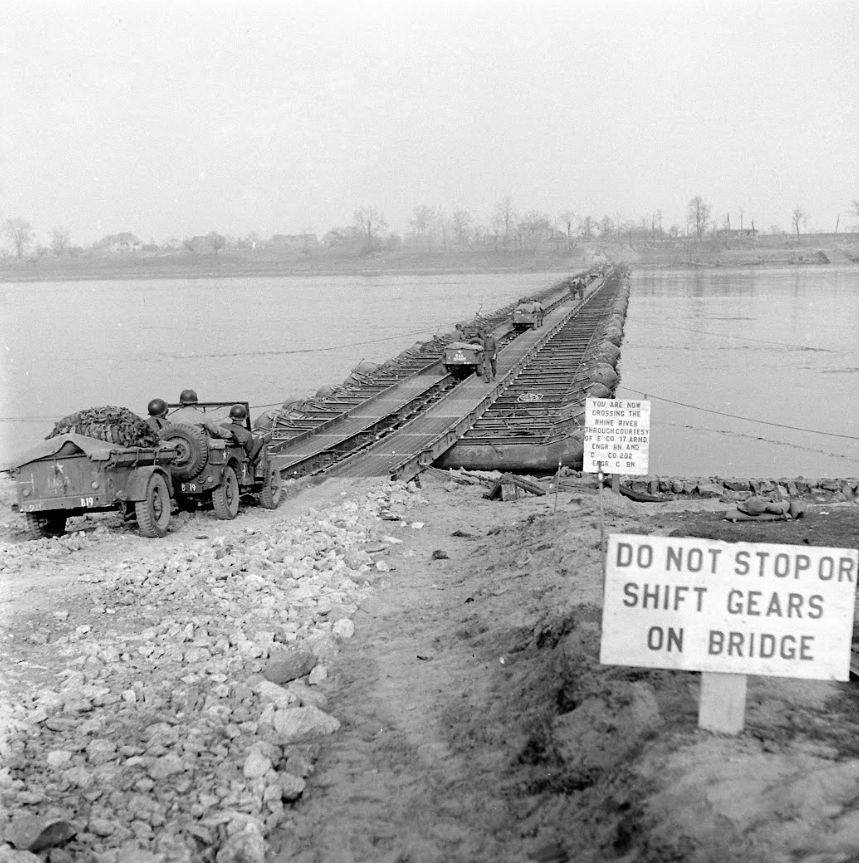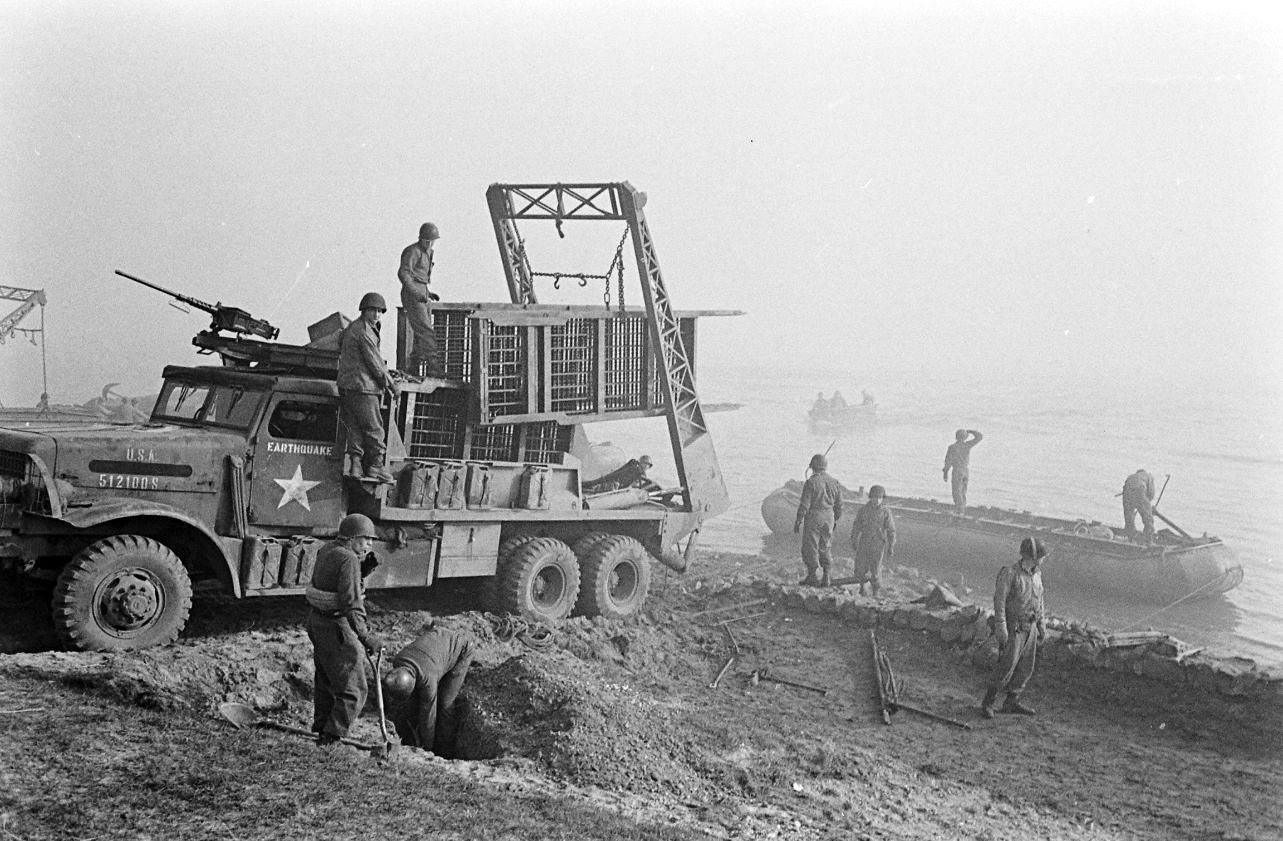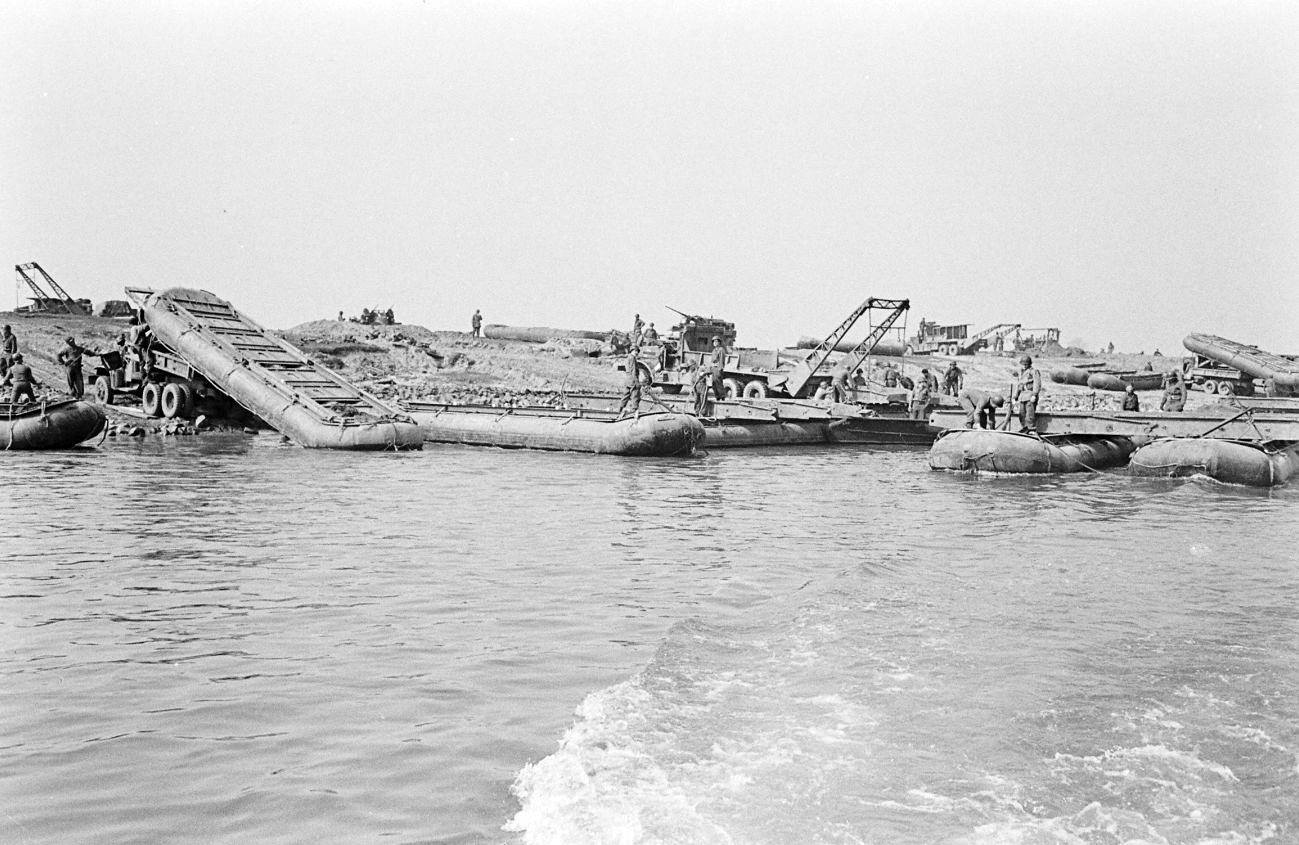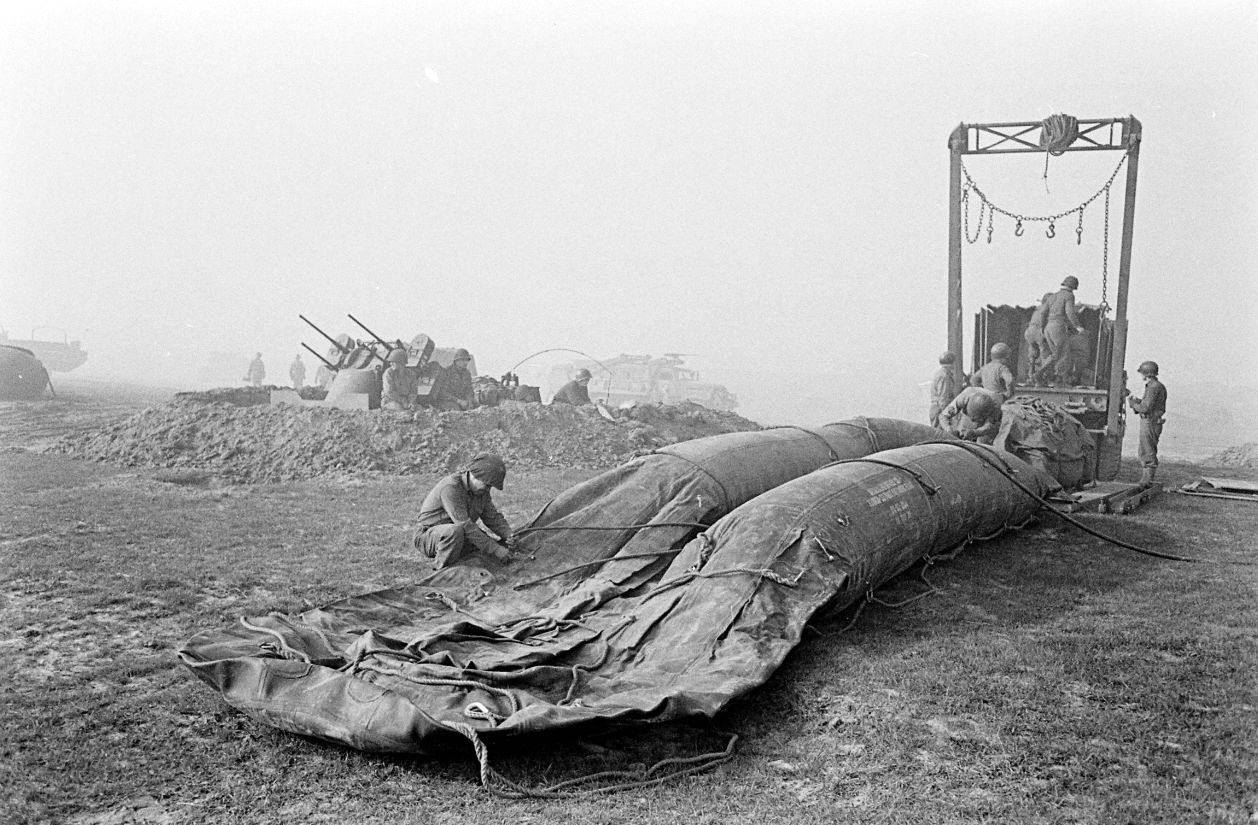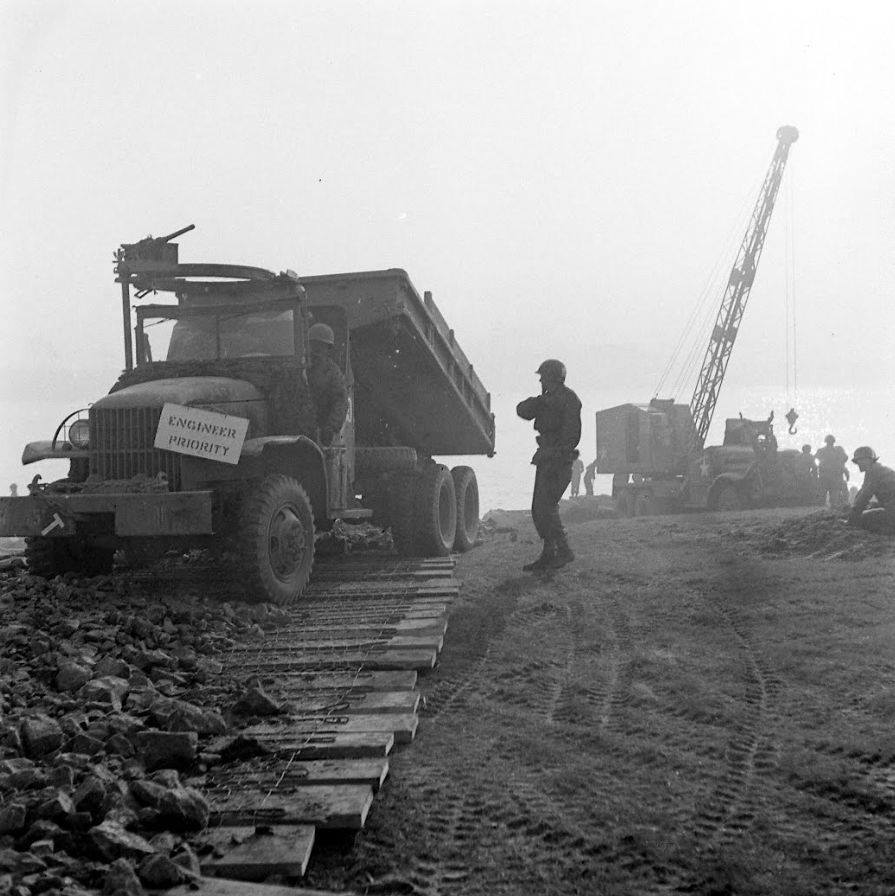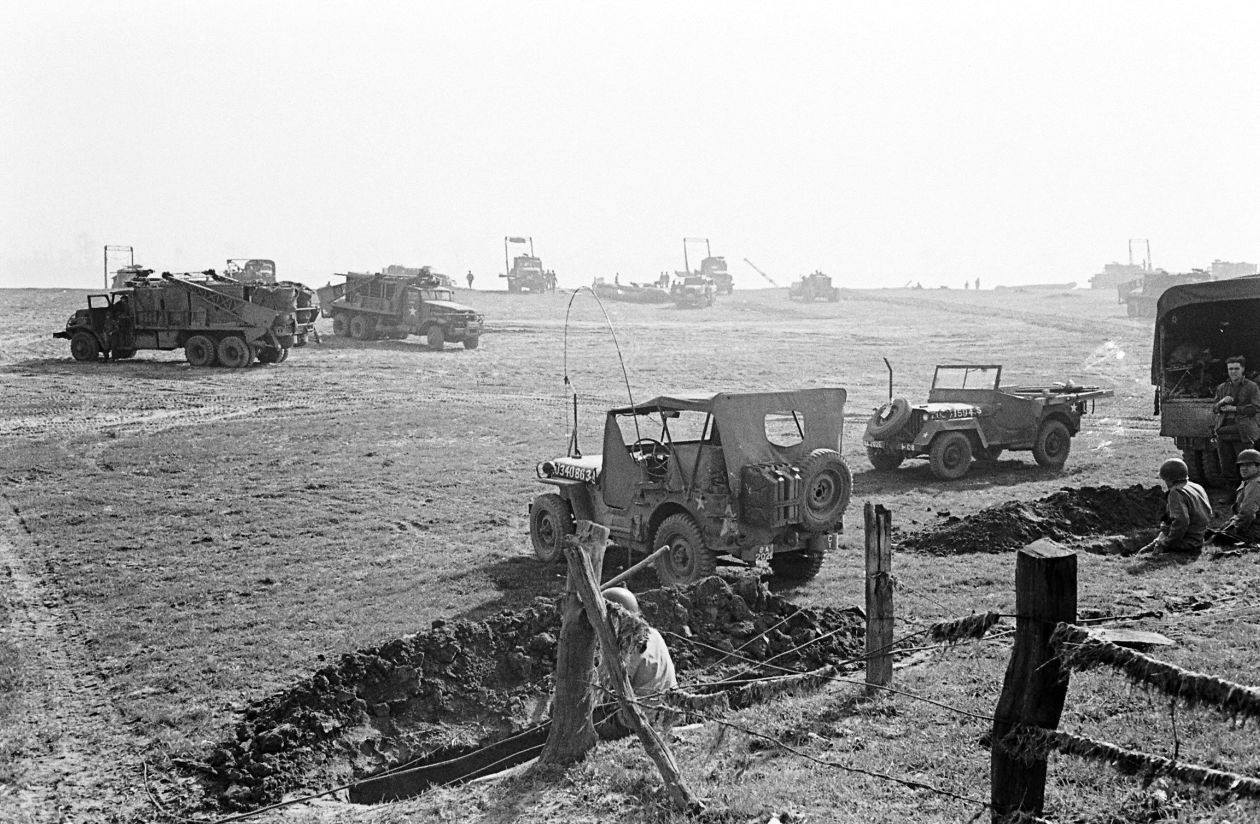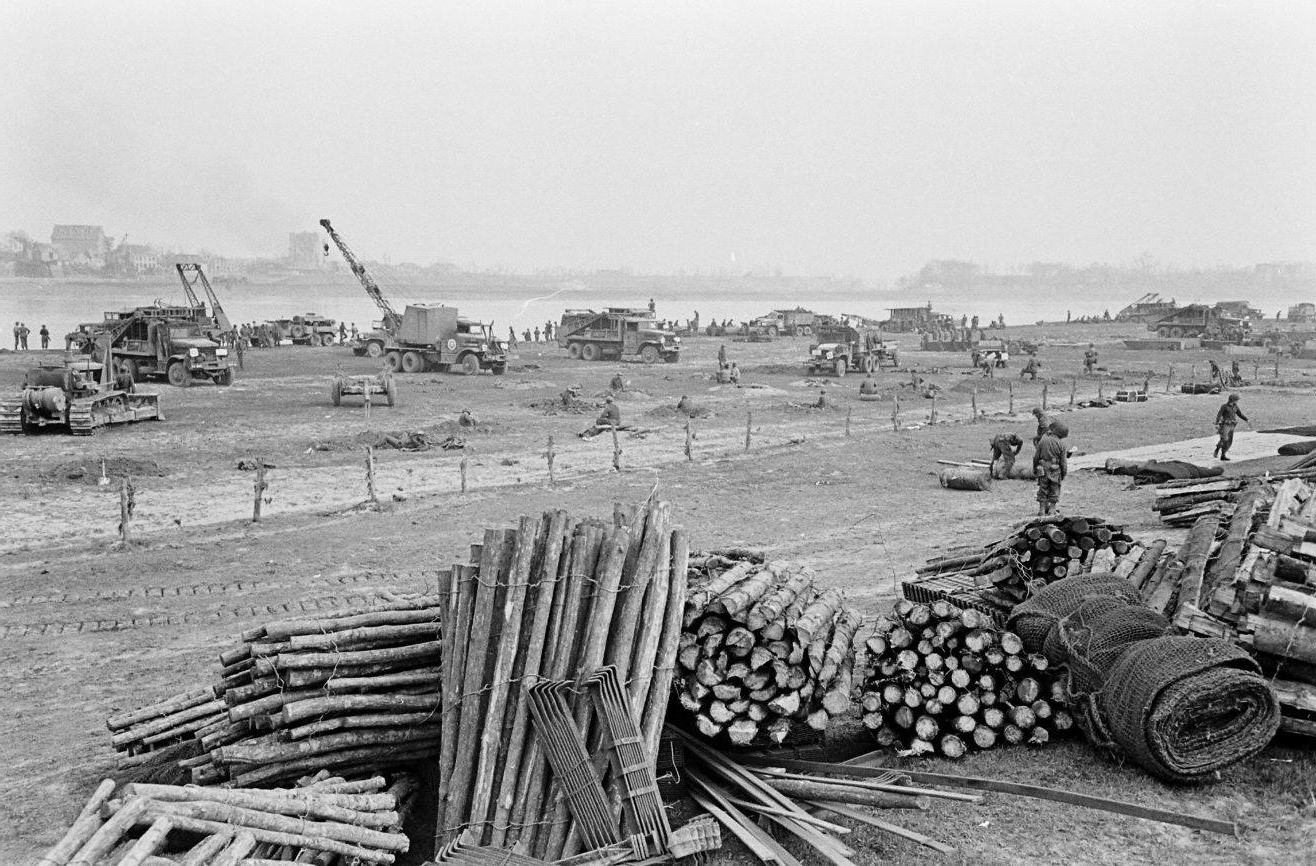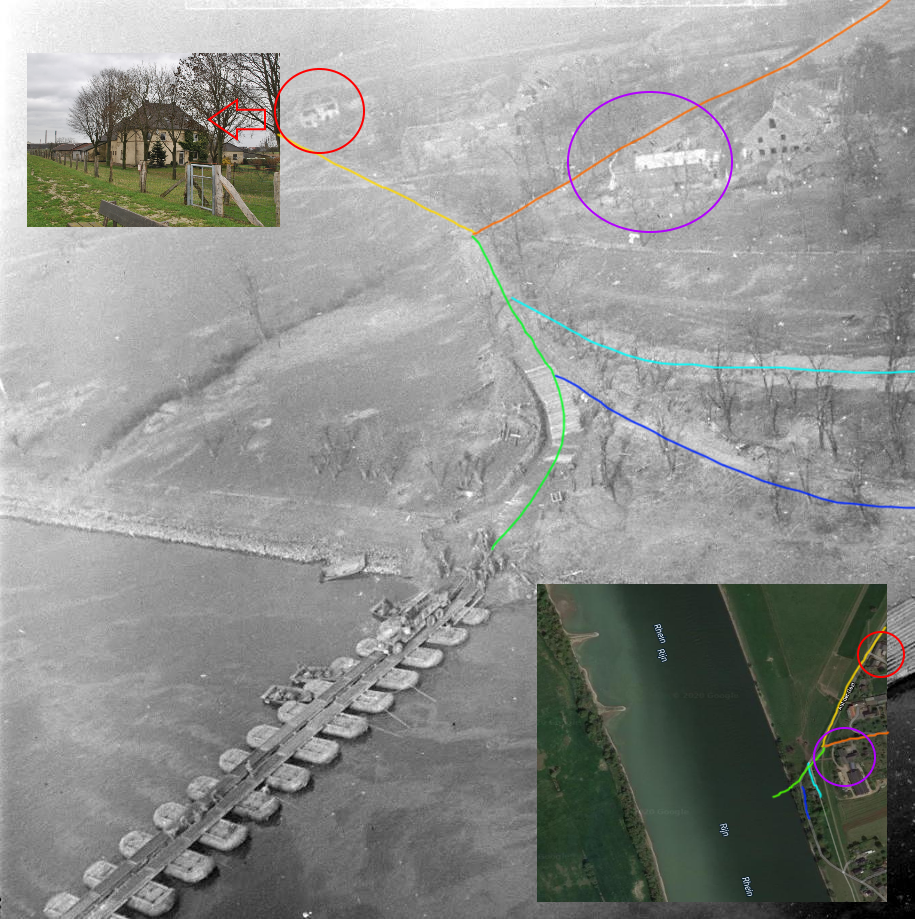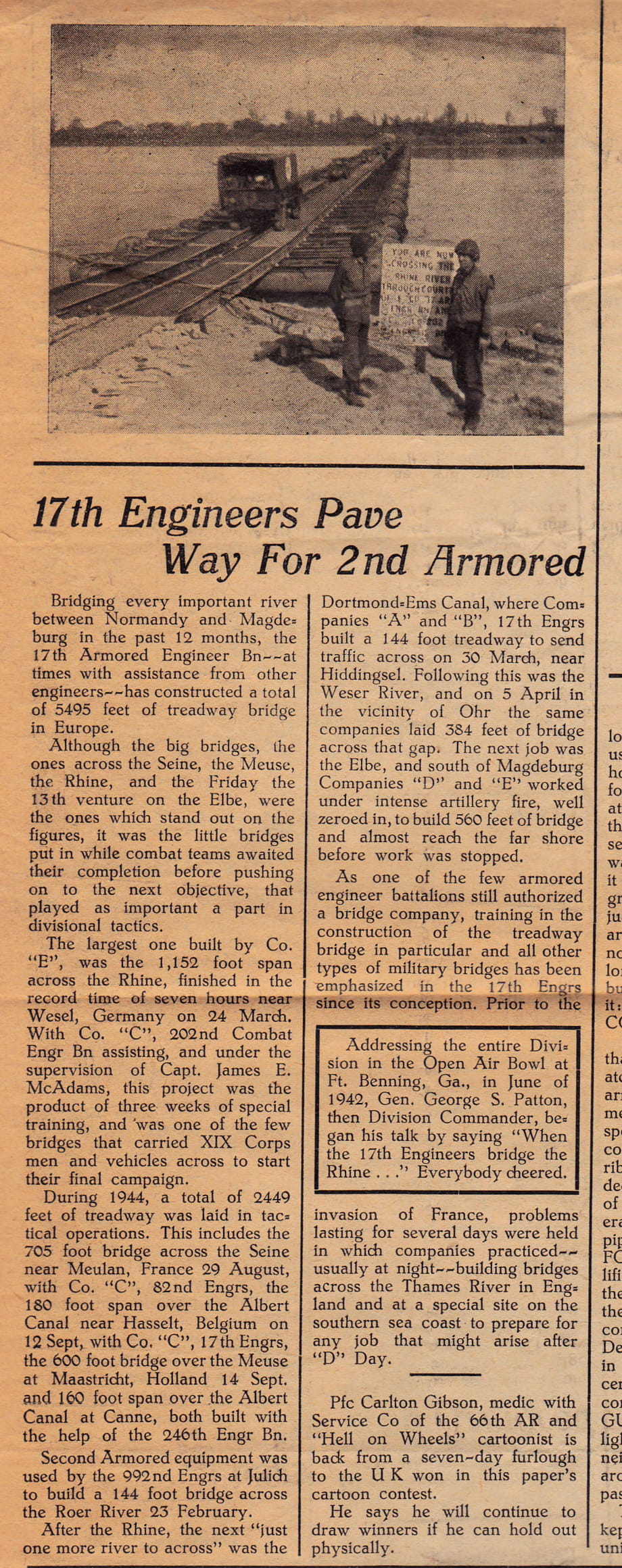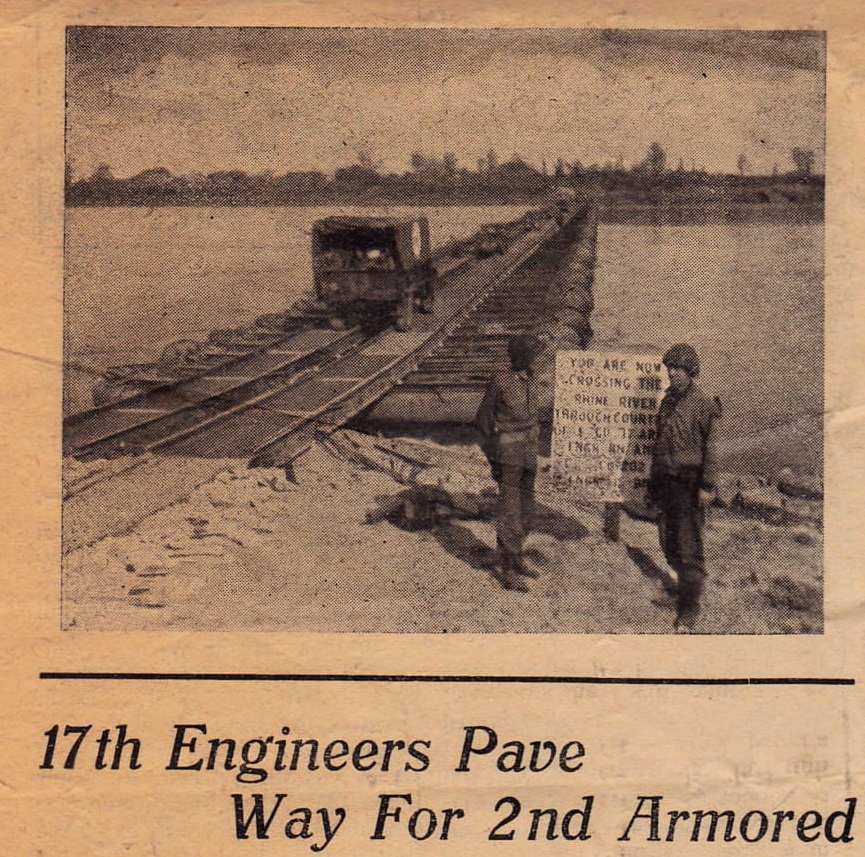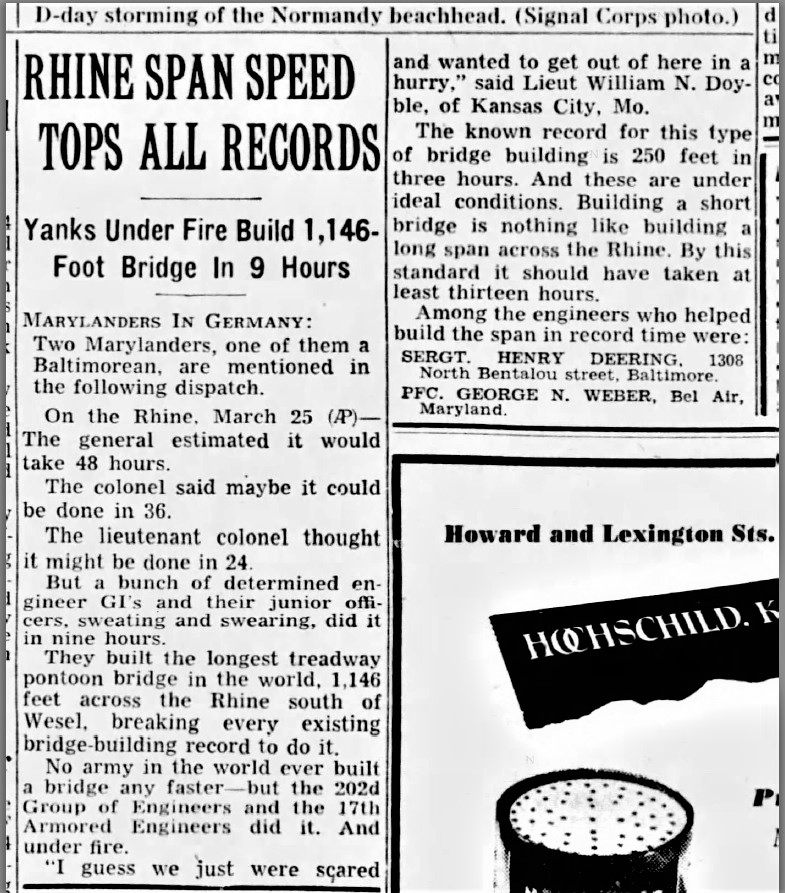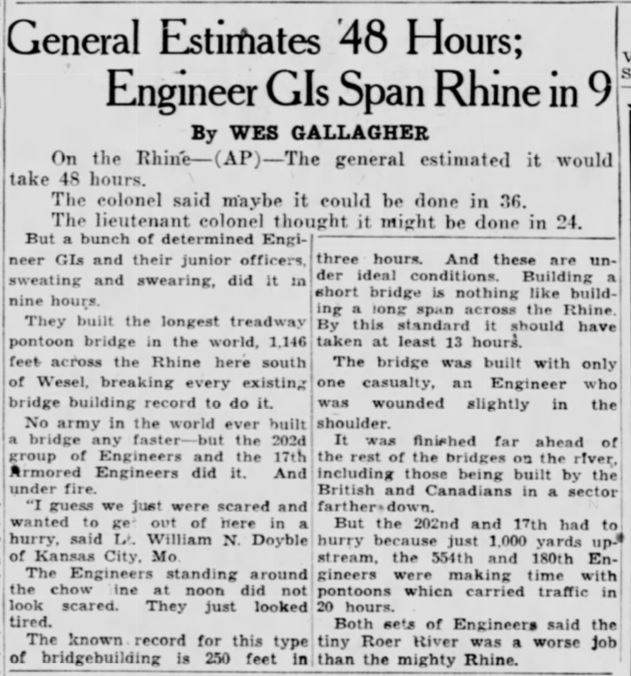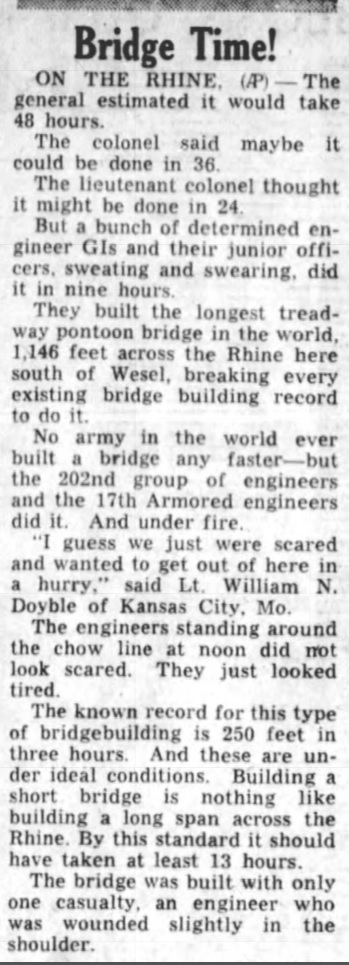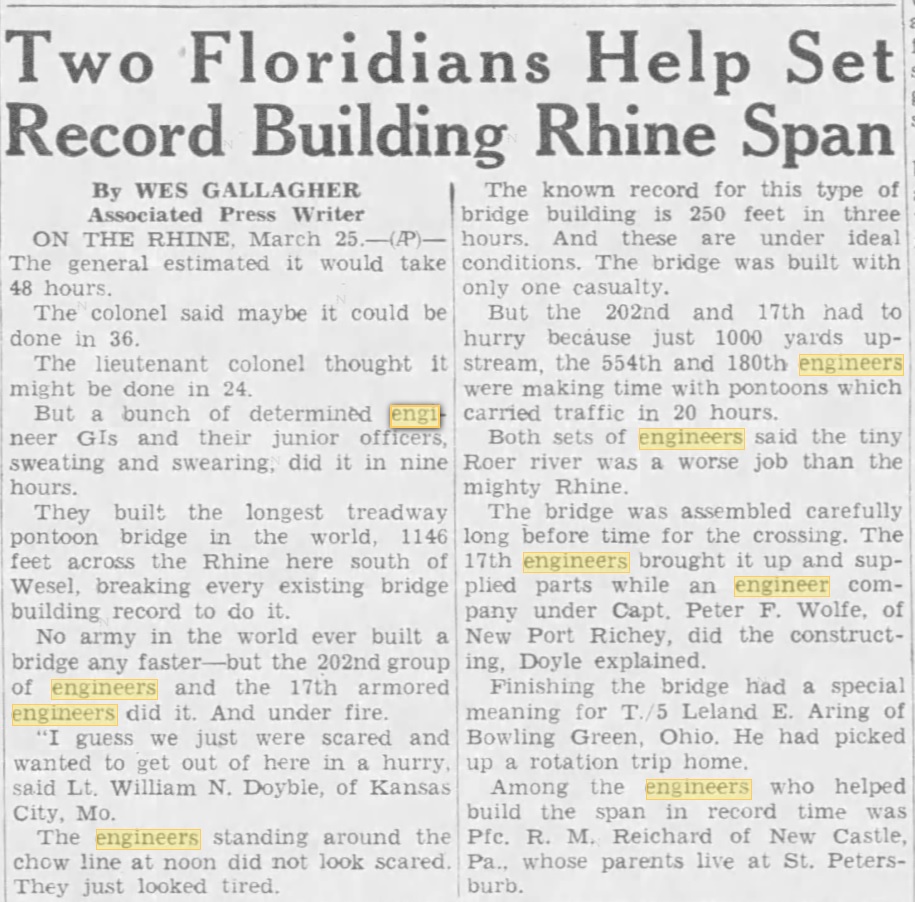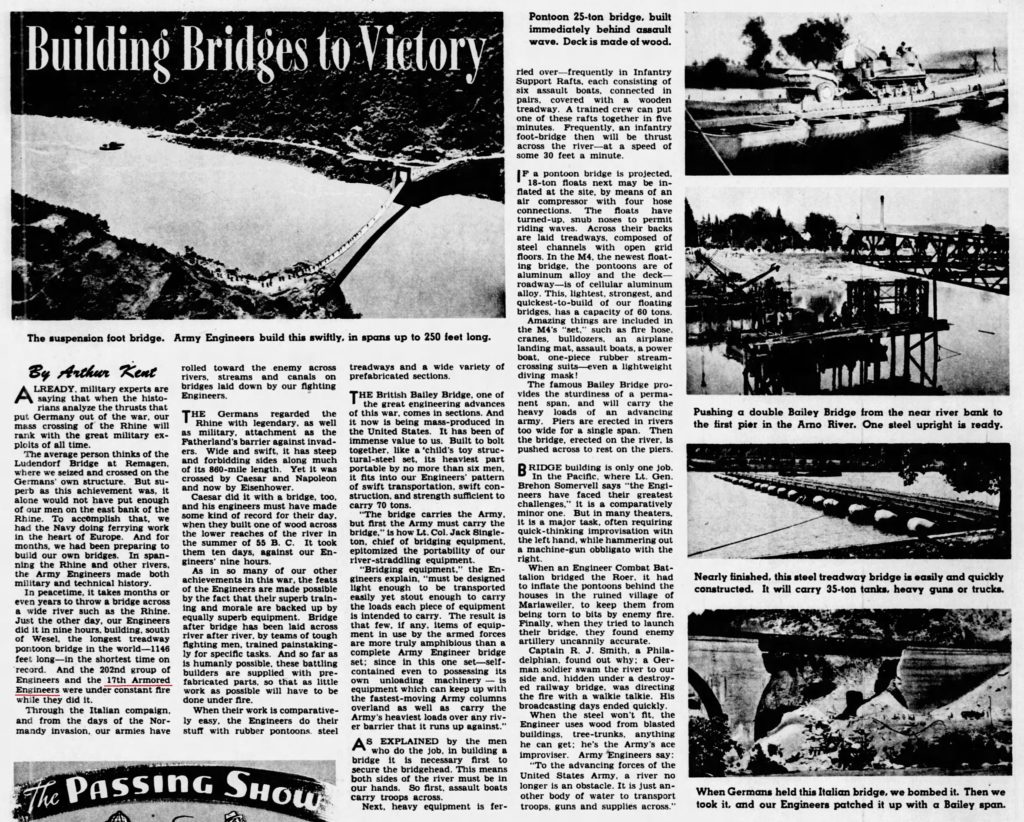M2 Treadway bridge across the ” Rhine” on 23 March 1945 near Spellen, Germany
UPDATED 07-2021
Photos treadway bridge:
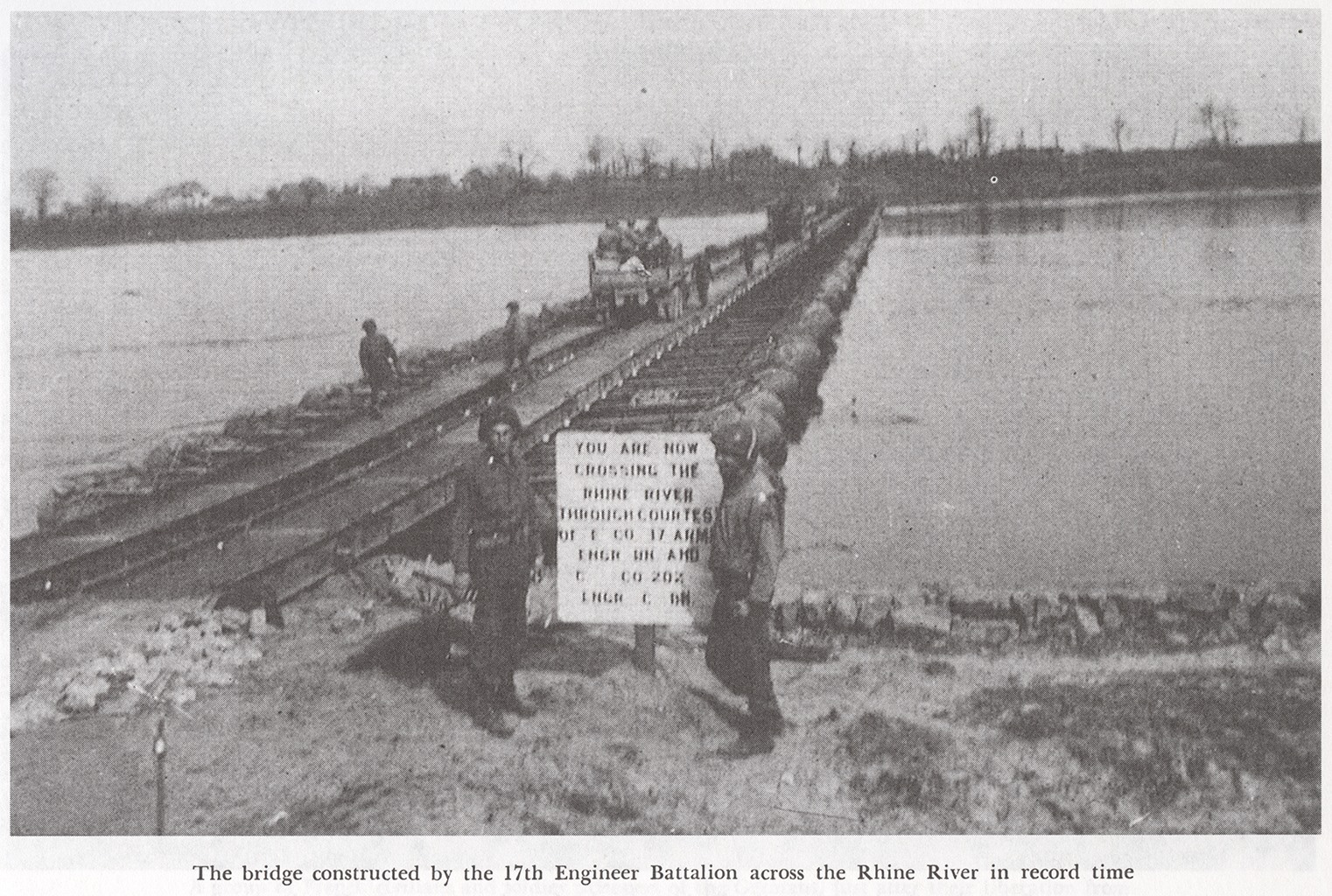
Bridge Rhine River 17th AEB in record time, Source: Book, A history of the 2nd United States Armored Division 1940 – 1946 by The Battery Press
10-2020
01-2021
Original photos taken by Technical Sergeant Gordon J Ketchpaw, 17th Armored Engineer Battalion, E Company
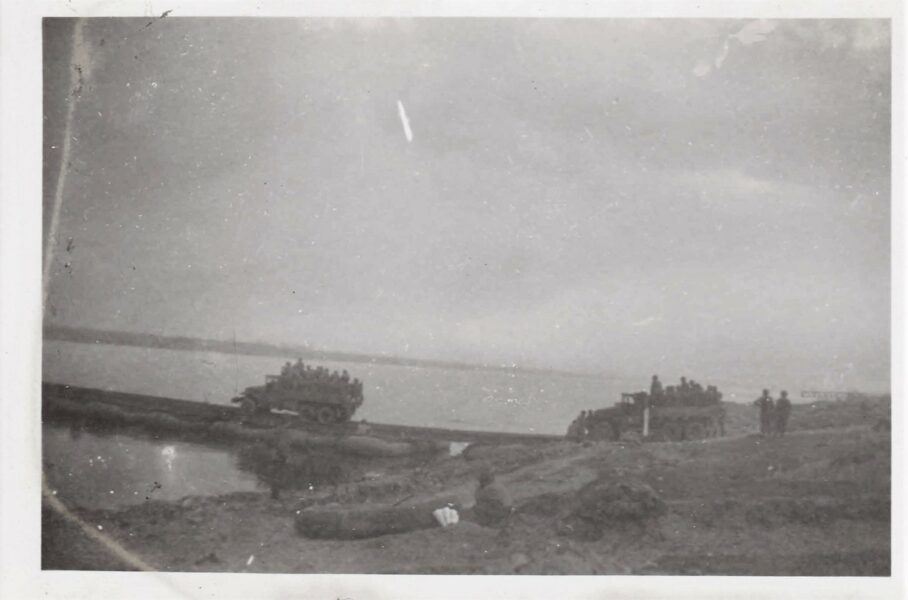
Technical Sergeant Gordon J Ketchpaw; “The First trucks to cross their Rhine river bridge”, Germany, March 23, 1945 (Courtesy: Dave Ketchpaw)
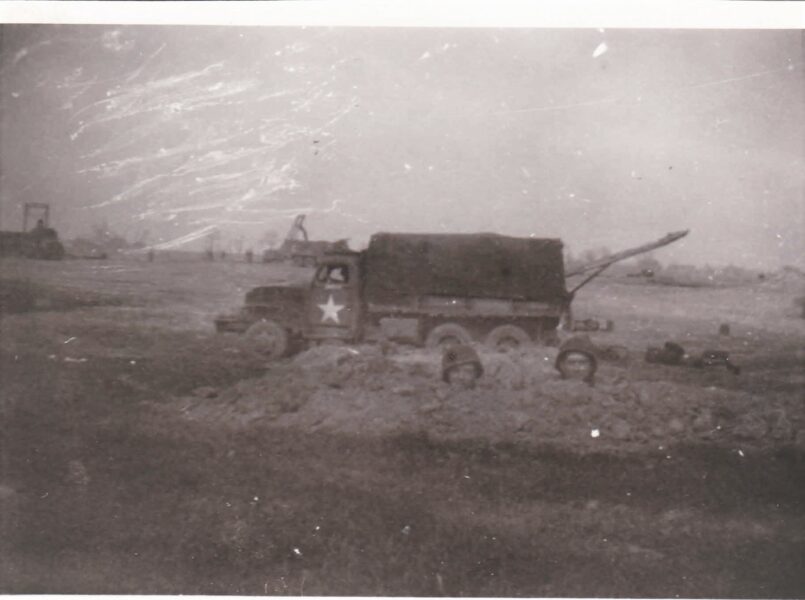
Technical Sergeant Gordon J Ketchpaw; “Rhine river, men seeking shelter”, Germany, March 23, 1945 (Courtesy: Dave Ketchpaw)
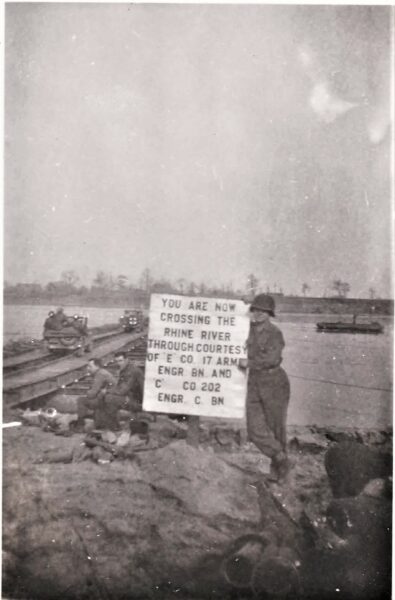
Technical Sergeant Gordon J Ketchpaw; “Crossing the Rhine courtesy Co E 17th Armd Eng Bn + C Co. 202 Eng”, Spellen, Germany, March 23, 1945 (Courtesy: Dave Ketchpaw)
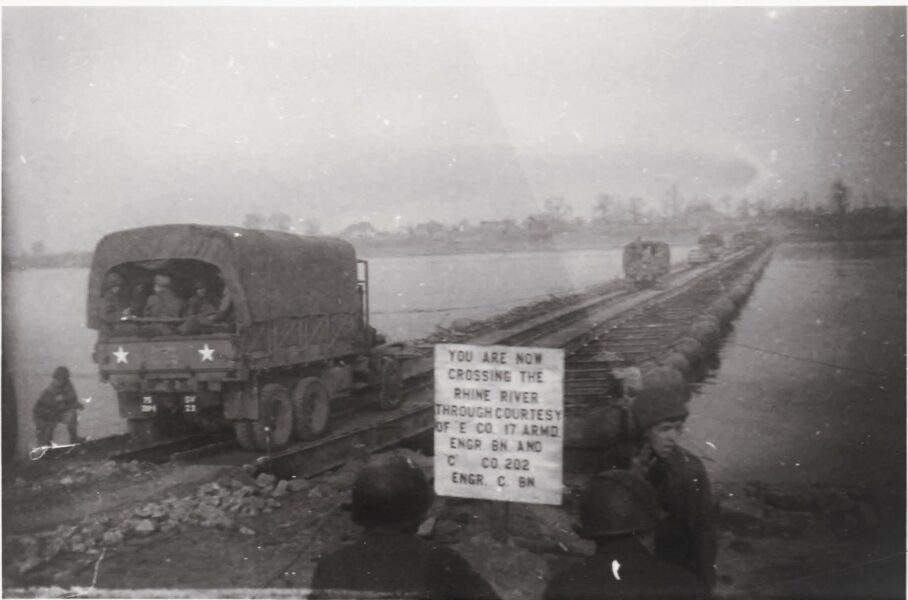
Technical Sergeant Gordon J Ketchpaw; “Crossing the Rhine courtesy Co E 17th Armd Eng Bn + C Co. 202 Eng”, Spellen, Germany, March 23, 1945 (Courtesy: Dave Ketchpaw)
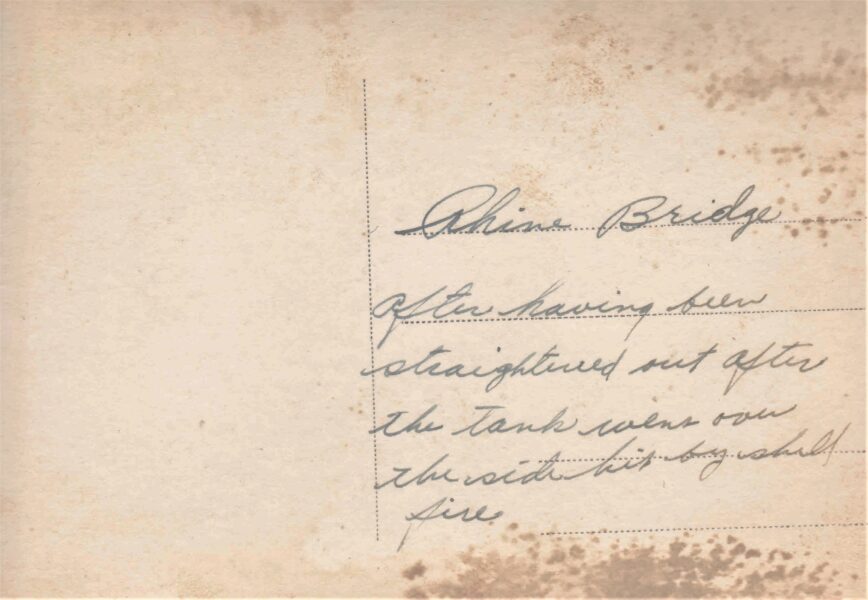
Technical Sergeant Gordon J Ketchpaw; “Crossing the Rhine after tank falls off”, Spellen, Germany, March 23, 1945 (Courtesy: Dave Ketchpaw)
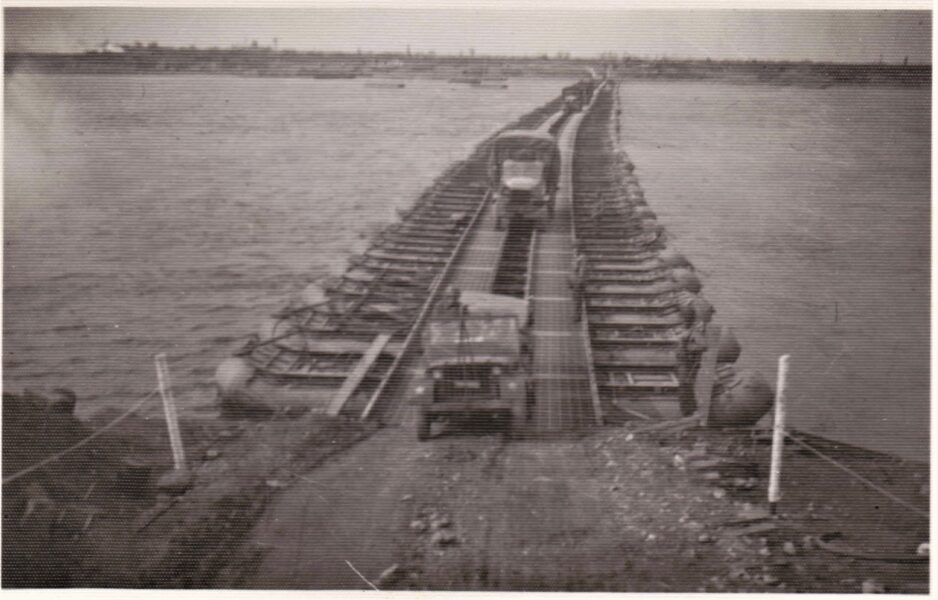
Technical Sergeant Gordon J Ketchpaw; “Crossing the Rhine after tank falls off”, Spellen, Germany, March 23, 1945 (Courtesy: Dave Ketchpaw)
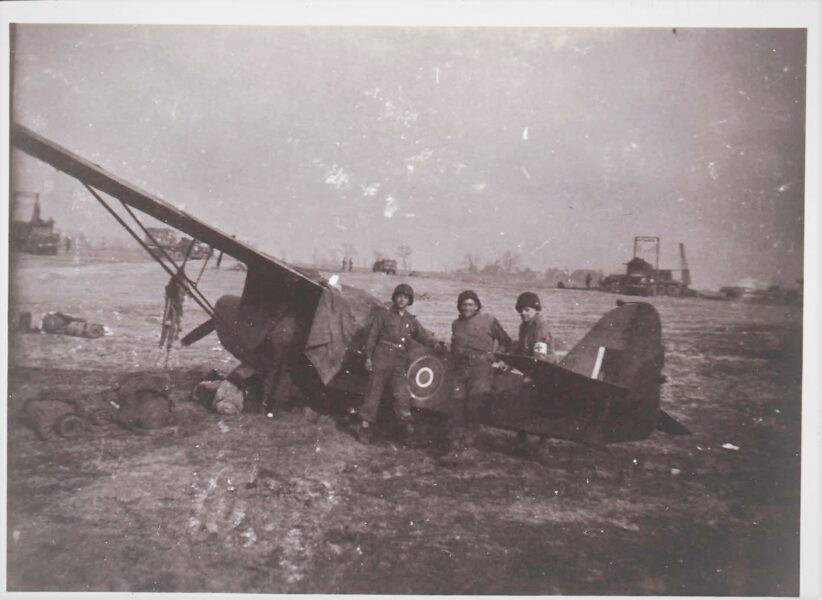
Technical Sergeant Gordon J Ketchpaw; “Britisch recon plane downed by balloon cable at the Rhine”, Spellen, Germany, March 23, 1945 (Courtesy: Dave Ketchpaw)
Constructed by:
Company E and C of the 17th Armored Engineer Battalion, 2nd Armored Division (with Co. “A“ 202nd Engineers attached during the training but later released)
Date:
March 24, 1945
Build in time:
“start 6hours and 15 minutes, Bridge construction started at 9:45am and by 4:00pm the first truck crossed the floating Pontoon bridge.”
“Construction of the bridge started at 0630, until 0815 on site”
Location:
Germany, location place called “Spellen” 5 kilometres south of Wesel across the river Rhine.
(* A207344 = original map location from “After Action rapport” in google maps: 51°35’37.7″N 6°35’33.6″E)
Length:
1,112 foot span (Source: Facebook page WW2 Radio by Henri Paul James)
Over 1,152 ft (351 m) (Source: Unit Histrory 17th Armored Engineer Battalion)
Maps:

Map, pontoonbridge crossing at Spellen
(Source: Book; Engineer operations in the Rhine River crossing, Ninth US Army 1945)
Detail sign on the bridge site:
Battle Honors: Presidential Citation Easy Company 17th Armored Engineer Battalion
Authentic Film
In the first minute in this film the Treadway pontoonbridge can be seen in use.
(Source: Tanks in World War II, 2nd Armored Division: “Hell On Wheels” pt2-2 1951 US Army; Public domain film from the National Archives, from Youtube.com)
(update 2020: not online anymore https://www.youtube.com/watch?v=OMz14hyDREA)
Moviestills:
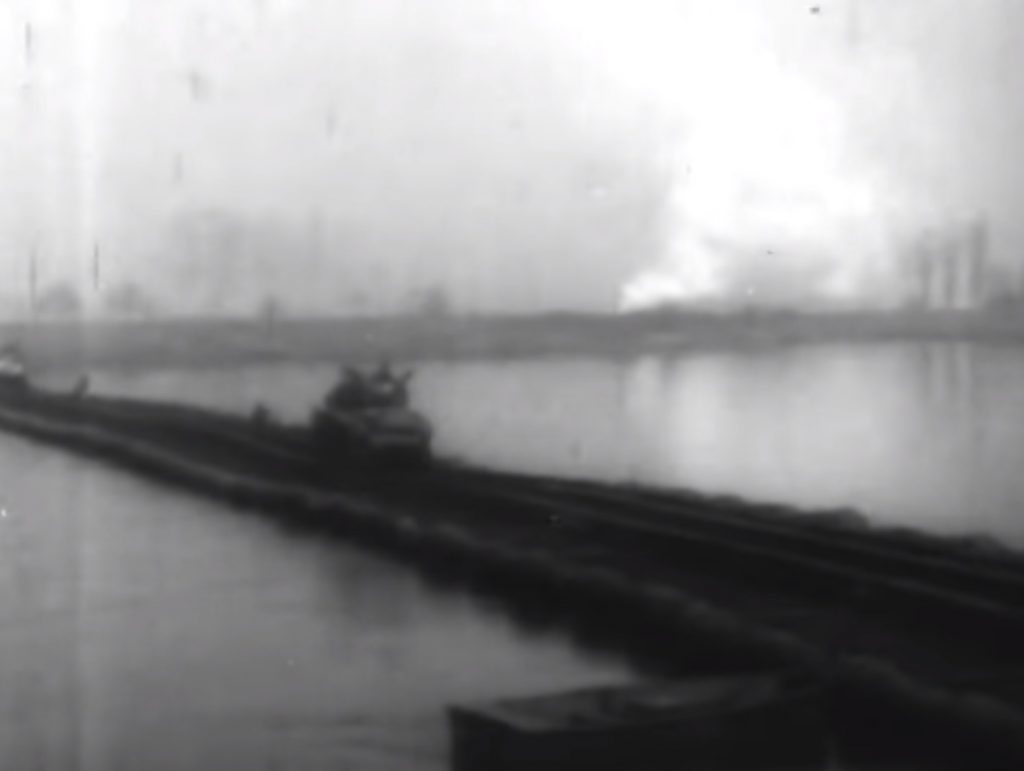
Movie still
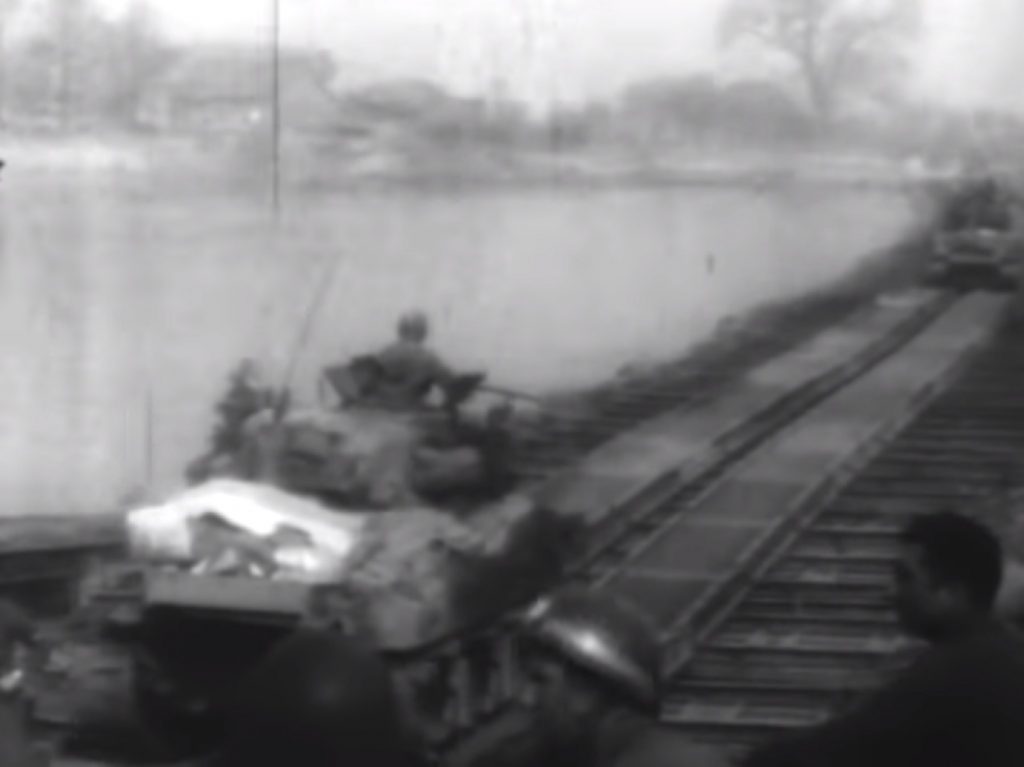
Movie still
“07-2021”
Interview recording, The Grout Museum District
Kephart_Ralph_kiosk_70818.mov from Grout Museum District on Vimeo. Source: groutmuseumdistrict.org
Read more about Ralph Kephart here: Ralph Edward Kephart
Original photos of constructing the bridge:
Source: Facebook page WW2 RADIO by Henri Paul James
On the night of 23 March, Company E and C of the 17th Armored Engineer Battalion,
part of U.S. 2nd Armored Division, constructed treadway rafts to prepare the crossing of the Rhine River about five kilometres south of Wesel.
Bridge construction started at 9:45am and by 4:00pm the first truck crossed the floating Pontoon bridge.
Over 1,152 ft (351 m) of M2 treadway and 93 pneumatic floats were used in just six hours and fifteen-minute construction project,
record setting for the size of the bridge.
It took twenty-five 2-and-a-half ton GMC CCKW trucks to transport the bridge parts to the construction site, part of the Red Ball Express
10-2020
10-2020
Information: ” Book; Engineer operations in the Rhine River crossing, Ninth US Army 1945″
“Company E, 17th Armored Engineer Battalion, Second Armored Division, (operated as a separate company) (with Company C, 202d Engineer Combat Battalion attached): to construct the M2 treadway bridge in the vicinity of Wallach.”
3202 veel hits verwerkt“30th INFANTRY DIVISION ZONE.
Division Engineers: 105th Engineer Combat Battalion.
Direct Support: 1153rd Engineer Combat Group, composed of:
Headquarters and Headquarters Company, 1153rd Engineer Combat Group
258th Engineer Combat Battalion
202d Engineer Combat Battalion
280th Engineer Combat Battalion
234th Engineer Combat Batalion
171st Engineer Combat Battalion 180th Engineer Heavy Ponton Battalion
554th Engineer Heavy Ponton Battalion
Company E, 17th Armored Engineer Battalion (Treadway Bridge Company, 2nd Armored Division)
989th Engineer Treadway Bridge Company
73d Engineer Light Ponton. Company
1355th Engineer Dump Truck Company
747th Tank Battalion (less Company 13) Detachment, Naval Unit 122.5.3 (Crews for g LCVPs and 9 LCMs) Detachment, 329th Harbor Craft Company (Crews for 6 Seamules) 553d AAA AW Battalion (Mbl) (Less Battery B) (Attached for operations only)”“M2 TREADWAY BRIDGE AT WALLACH.
The M2 treadway bridge site at Wallach required construction of 2400 feet of road on the near shore and 600 feet on the far shore for connection with the existing road net. Only minor work was necessary to prepare the abutments. At 0430 on D-day an improvised approach road consisting of Sommer feld track and timber planking covered with crushed rock and gravel had been constructed. Construction of the bridge started at 0630. Until -0815 site. These dump trucks were loaded on the afternoon of D-1. On D-day Brockway trucks, as well as the dump trucks, were utilized to transport the treadways and standard loads necessary to complete the bridge. Construction was carried on at three section assembling sites, one of the assembling sites being downstream and two upstream from the bridge. Stocks of spare parts, anchor cable, anchors, rope, and other equipment had been placed at each assembling site.
Intermittent artillery fire interfered with construction several times, particularly when the smoke screen over the bridge site lifted and permitted enemy observation. One of the assembling sites had to be moved a few hundred yards after enemy artillery had registered on it. Another site had to he moved as the bridge neared completion to avoid interfering with the guy lines. Since one power utility boat could handle only a two ponton section, this size of raft was used in assembly of the bridge. One 200-pound upstream anchor was used on each float and a 100-pound downstream anchor was used on every second float, making a total of 216 anchors for the bridge.”
Information internet:
In the night of 23 March, Company E and C of the 17th Armored Engineer Battalion, part of U.S. 2nd Armored Division, constructed treadway rafts to prepare the crossing of the Rhine River about five kilometres south of Wesel.
Bridge construction started at 9:45am and by 4:00pm the first truck crossed the floating Pontoon bridge.
Over 1,152 ft (351 m) of M2 treadway and 93 pneumatic floats were used in just six hours and fifteen-minute construction project,
record setting for the size of the bridge.
It took twenty-five 2-and-a-half ton GMC CCKW trucks to transport the bridge parts to the construction site, part of the Red Ball Express
(Source: Facebook page WW2 Radio by Henri Paul James)
Information from the:
Official After action report from April 1st, 1945 to april 30th, 1945
20 Mar 45: Preparing for bridge operations.
23 Mar 45: Company alerted for bridging operations. 1st platoon 1355th Engineer Dump Truck company attached to this company for operations. Two (2) Ducks attached for operations. One (1) crane attached for operations.
Report of Operations of Company Easy 17th Armored Engineer Battalion, continued.
24 Mar 45: Constructed 1152 M2 Treadway Bridge on Rhine River at a207334 vicinity SPELLEN, GERMANY.
25 Mar 45: Maintenance of Bridge at A207344*.
26 Mar 45: Continued maintenance of bridge. All attached units relieved from attachment to company. Drawing new bridge equipment from dump.
27 Mar 45: Relieved from attachment to 1153rd Engineer (Charlie) Group. Continued maintenance of Bridge. Continued drawing equipment.
28 Mar 45: Continued maintenance of bridge. Returned damaged equipment to dump.
29 Mar 45: Completed drawing bridge equipment from dump. Company relieved of maintenance of bridge.
(* A207344 = original map location from “After Action rapport” in google maps: 51°35’37.7″N 6°35’33.6″E)
Information from the Unit History:
At Maastricht Company E began on intensive training program to orient the unit working with it in the organization for and construction of the tread way bridge, as Co. “C’, 202nd Engr C Bn had no previous experience with this type equipment. For six days (with Co. “A“ 202nd Engineers attached during the training but later released), all personnel of Co. “E” did what they could to share their knowhow of the tread way with the men who would work with these on the biggest job yet to confront them. Twice practice bridges were build across the Meuse under simulated combat conditions, using artificial moonlight and fog. An airplane reconnaissance trip of the Rhine site was made by Capt, James E. McAdams, CO of Co. “E”, and selected NCOs. Orders came to construct the bridge, and during the early hours of 24 March, with Capt. McAdams Coing ahead to make a ground reconnaissance of the far shore, the trucks moved up to the Rhine in the vicinity of Weser.
After arrival at the site a change in instructions ordered the building of rafts to ferry vehicles across. This was done. Enemy small arms fire, which had been fairly strong when the group first arrived at the area, now began to diminish, but incoming artillery was arriving with more frequency. Construction of the bridge, nevertheless, started at 08:35 and work progressed in a very satisfactory manner, the reward of meticulous planning and hard labour. Artillery fire caused 20 casualties before the last float was worked into place 7 hours later. At 1530 the bridge was opened to traffic a 1,112 foot span completed in less time than any ether bridge across the famed barrier.
Shortly afterwards, however, the bridge was endangered when a ferry loaded with a tank broke loose from its mooring upstream and at 1630 drifted into the bridge, sinking itself and destroying nine floats. Several sections of tread way went under water. The engineers rushed to the scene and used explosive to break the damaged part of the bridge loose for repair and replacement. Enemy planes strafed the workers. but by 0200, 25 March the bridge again was open to traffic.
Article about Co E from Hell on Wheels June 13 1945
The newspaper was provided by Dave Ketchpaw. His father Technical Sergeant Gordon “Gordy” James Ketchpaw served in Company and worked on this crossing, read more about him here: Technical Sergeant Gordon “Gordy” James Ketchpaw.
Information from: The Baltimore Sun (Baltimore, Baltimore, Maryland, United States of America) · 26 Mar 1945, Mon · Page 3:
RHINE SPAN SPEED TOPS ALL RECORDS
Yanks Under Fire Build 1,146-Foot Bridge In 9 HoursMARYLANDERS IN GERMANY:
Two Marylanders, one of them a Baltimorean, are mentioned in the following dispatch. On the Rhine, March 25.
The general estimated it would take 48 hours. The colonel said maybe it could be done in 36. The lieutenant colonel thought it might be done in 24. But a bunch of determined engineer GI’s and their junior officer sweating and swearing, did it in nine hours. They built the longest treadway pontoon bridge in the world, 1,146 feet across the Rhine south of Wesel, breaking every existing bridge-building record to do it. No army in the world ever built a bridge any faster – but the 202d Group of Engineers and the 17th Armored Engineers didt it. And under fire. “I guess we just were scared and wanted to get out of here in a hurry,” said Lieut William N. Doyble, of Kansas City, Mo. The known record for this type of bridge building is 250 feet in three hours. And these are under ideal conditions. Building a short bridge is nothing like building a long span across the Rhine. By this standard it should have taken at least thirteen hours. Among the engineers who helped build the span in record time were: SERGT. HENRY DEERING. 1308 North Bentalou street. Baltimore. PFC. GEORGE N. WEBER, Bel Air, Maryland.
Current location Bridgecrossing:
(* A207344 = original map location from “After Action rapport” in google maps: 51°35’37.7″N 6°35’33.6″E)
Place nearby bridge:
Photos of the location of the in 2016
Researched by Arjen Kok and Martijn Brandjes 2020, updated 10-2020 updated Martijn Brandjes 07-2021
